#one inquisitor of many leading at the same time
Explore tagged Tumblr posts
Note
YOU HAVE A TORUNN TOO? :D
I DO LMAO I’ll share about mine if you want!!! And please feel free to share about yours!!! 😍



Sharing a current ongoing WIP of her (she’s posing with three of my other Inquisitors) & also a snapshot of her from a finished piece I did for the DA Createathon this year 🥰 And her original (more or less) design from Inquisition I definitely tweaked over the years of having her as an Inquisitor OC 💖
Also have a write-up about her I also shared with that server, which I’ll quote here!!! (Note that I originally wrote this info about her pre-Veilguard!)
Torunn Adaar (she/her) is technically a Tal-Vashoth by birth, and she’s keenly aware of what her parents went through during their time in Par Vollen while living under the Qun. One of her biological mothers was a Saarebas, had her mouth sewn shut, and she was controlled similar to how we see Ketojan/Saarebas in DA2, except she only managed to escape when her partner, an until right then devoted member of the Antaam (at least, she seemed to be on the surface to most people, anyway) managed to kill the wielder and free her from her bonds (insert Pirates of the Caribbean quote here).
Torunn’s got two moms, the Saarebas and the former Antaam. Saarebas is a trans woman, and the two decided to conceive Torunn (so she’s not adopted) post-escape from the Qun. This is also why the magic flows more easily into her via the bloodline connection to her Saarebas mother, but Antaam is also why she’s really decent as a mage merc while fighting in battles.
I haven’t figured out a name for either Torunn’s Saarebas or Antaam, but I plan to, because part of her (Torunn’s) story is learning that they chose a name to give her with the intention of breaking the Qun norm of not naming anyone officially, and also the unofficial add-on about that that we learned in Inquisition regarding taking up a nickname (instead of a series of numbers) as a “name.” But, it’s ALSO to do with the idea that she (Torunn) is freely able to decide to change her name at any point, because it’s HERS and that’s her right as an individual (rights and freedoms both her parents did not have before leaving the Qun). Her parents aren’t anti-collectivist either for the record, but they also like being able to be autonomous individuals as well if able. Freedom and self-expression is a major theme in their relationship and desire to break free from the Qun, as well as in wanting strike out in a new life together outside of Par Vollen & their assigned roles in the Qun. Outside of it, they feel they can all be happier and do whatever they want without being beholden to strict laws governing their “place in the world.” This, however, does leave Torunn with some intrigue regarding the culture she is connected to, and she has conflicting feelings regarding her own identity as a qunari born outside the Qun with parents who left the Qun (and not on the best of terms).
Also, Torunn eventually specializes her magic into necromancy, as she finds spirits and the dead a lot easier to learn things most of the living world would rather she never even hear about. That, and she has a very sweet and strong connection with the spirit who inhabits her skull she carries (info on whom & which I’m still figuring out).
Torunn is an asexual lesbian, as well, and eventually falls in love with and marries Josephine Montilyet, with whom she has the sweetest relationship 🥹 They support one another while allowing each other the space in which to grow and understand the world better, and never let work fully separate them. After Trespasser, Torunn moves with Josie when she moves back to Antiva, and lives with her as she manages her family’s estate (and does underground Inquisition business here and there, as in my over-arching world state, the Inquisition officially disbands but remains an underground secret organization, of which Josie and Torunn do still have some hand in aiding). Josie’s family adore her, which was a relief to Torunn, as after hearing what high society elsewhere (Orlais and Ferelden, specifically) referred to her as during her time as joint Inquisitor with the others, she was definitely concerned her beloved’s family would be just as racist and unwelcoming. It’s been a wonderful surprise, and a nice life they both lead together.
#dragon age#my inquisitor#my ocs#torunn adaar#inquisitor adaar#lesbian oc#mage oc#necromancer oc#qunari oc#tal vashoth#one inquisitor of many leading at the same time#josephine montilyet#oc info
4 notes
·
View notes
Text
Space Marine Cuddle Pile Pt 4
Part 1 - Part 2 - Part 3 - Part 5
Writing Master post
Cuddly boys are back! Come join in the pile!
@lazywriter-artist @wolf-feathers12
Imagine:
A chaplain sitting on the floor. One Astartes leaning against him. Another rests their head on his lap. A third rests again the Chaplains back. He has his arms around the two marines he can reach. They witnessed their brother torn apart by daemons then be possessed. They had to grant him the Emperor’s mercy. It is the chaplain’s job to comfort and guide them.
A very disgruntled Ad Mech. They’d been warned. Several times. They’re drinking. Don’t go in there. You won’t be able to do any work. Yet they brushed it off. Now they were pinned against a Space Wolf’s chest, the arm of one and the leg of another on top of them. They all drooled snd snored loudly as they curled up with one another. The Ad Mech was stuck there for a bit. They would not be finishing their tasks anytime soon. The one whose chest they were on wrapped his arms around them and sleepily nuzzled their head.
A Sanguinary Priest holding onto a blood Angel that experienced the Red Thirst for the first time. Comforting the battle brother as he cries for the terror of it or if he caused any casualties.
A Drukhari is absolutely mortified. What they initially thought was an attack was not. They stand there, stiff as a board and utterly confused and not sure if they should be disgusted or not. The warband of chaos marines they had been with suddenly surrounded them then plopped themselves on the floor and wrapped their arms around each other. Drukhari in the middle. Is… is this some new… kind of torture? Psychological warfare?? It’s so warm and they seem.. happy?? These are the same marines they had flailed people with not even hours earlier and now they were doing… this.
The Lion and Guilliman have just reunited. There’s been official ceremony between both of their legions. Speaking to inquisitors and imperial high lords. Then the paperwork. Throne the paperwork. Then a feast. It’s been so much but now… it’s just the two of them. The only moment they’ve had since finding each other again. There’s so many unspoken emotions. Both positive and negative. The two brothers stare at each other, weary of what the other will do. Yet there is relief. Relief of no longer being alone. Neither can seem to find the words so they go off of instinct. The longing to embrace and be embraced. The two hug, standing in silence. There’s nothing that action can’t speak for in this moment. Resting heads against each other, arms tight and fully encompassing the other. The imperium was slowly rebuilding. There were so many enemies. But it was okay. They weren’t alone. They were brothers. They’d support each other.
Every so often an “unlucky” custodian ends up surround by imperial fists. There’s no cause for alarm or defensive stance though. The Custodian just sighs and allows the Fists to lead them to where they’ve strategically set up various blankets, pillows, mattresses, and tapestries. Armor racks await near it to be used. All remove their armor and snuggle up close to the Custodian. Custodes are bigger than Space Marines. Being held by one feels safe and a bit like being held by a Primarch. It doesn’t happen too often and there’s always at least one custodian who will oblige. Plus, holding marines like babies is cute to them. The Sisters of Silence said so.
The invasion had been stopped. Carnage of tyranids lay everywhere. There’s one lone space marine that is in your village. Cut off from their squad as they defended you and your people. He waits patiently for his brothers to find him. You go up and place an arm over his, wishing to comfort him. This is what led to him lying on the ground with as many villagers he can hold. Since he saved you, you decide not to question it.
The Ravenguard have a set room for cuddle piles. It’s lovingly referred to as the nest. The softest blankets and pillows possible. Shiny objects decorate the walls and floor. It’s very well taken care of. No armor allowed in to prevent crushing anything or tearing fabric. You better have cleaned yourself up and gotten all that grime off of you before you step in. The chaplain is watching. It seems small but so many ravenguard can fit in there like sardines in a can. Curled up in blankets and around each other. Don’t tell Kayvaan but some marines have actually forgotten where their room is because they always sleep in here.
The Emperor claimed he had no regrets. But now he most certainly had one. He lay there, dying and fading away. Sanguinius’s body is off to one side and the body of Horus to the other. He thinks back to the vow he made. He wouldn’t get attached to his sons. It caused weakness. He would not hug or embrace them. This was too important. Yet now his heart ached. He wished he could have held them all at once in his arms when they were babies. To have greeted them with an embrace. Call them all to his room and roost around his bed as he held them. He wished he had. At least once. Especially the ones now dead. Two and eleven included. He had no strength left. He couldn’t crawl to the two bodies near him and hold them. After all, he was a cuddly man by nature. The Astartes and primarchs all got it from somewhere.
Even after turning to chaos, Fulgrim had days where memories and emotions overwhelmed him. Sending him into deep melancholy. It was these days that N’Kari would wrap themselves around him and clasp their arms around him. Have him surrounded by soft warmth. Some days he just wanted to be held.
A few orks once spotted a space marine cuddle pile. It must be some sort of strategy or trick. It seemed to make those beaky gits fight better. They don’t know its purpose or what it’s for but they attempt their own cuddle pile. The biggest lays down first then the others and finally the gobbos. It’s silent for a few moments as they try to figure out what it does. One snorts and struggles to hold in laughter. It’s followed by snickering and hushing. It’s another that breaks first. It’s now just a big pile of laughing and giggling shrooms.
#warhammer 40k#wh40k#warhammer community#space marine#warhammer 40000#40k#my writing#space marine cuddle pile#fulgrim#emperor of mankind#roboute guilliman#lion el'jonson#adeptus custodes#imperial fists#raven guard#drukhari#orks#40k orks#warhammer 30k#warhammer40k#warhammer#blood angels#kayvaan shrike#adeptus astartes#astartes#heretic astartes#horus heresy
202 notes
·
View notes
Note
Can you elaborate on what you think would be the minimal needed changes to fix what you see as an issue in Civ? Civ has done fairly large shifts in some mechanics before, and "civ like" is still an interesting game space that can scratch certain itches
yeah i mean as i said, the baked-in racism arises from a certain set of core assumptions that i think lock it into that position, which are that civ is a
1) symmetrical
2) 4X
game about
3) 'real world civilizations' (deeply loaded terms ofc but that's how civ envisions them)
4) trying to 'win the game'
5) with a global
6) and transhistorical
scope
so, in its role as a symmetrical (1) game with victory conditions (4), civ as a text has to take positions on what constitutes a 'successful civilization'. as a (2) 4X game this definition also has to include some variation on the profoundly loaded eponymous Xs, 'explore, expand, exploit, and exterminate'. furthermore, as a (1) symmetrical game with a global, transhistorical (5, 6) scope, it has to necessarily create a model of what 'a civilization' looks like and apply it to every 'civilization' it wants to include, at all points in their history.
this all kind of naturally leads into civ being a game in which the colonial european imperialist powers are the default 'civilizations' and all other cultures are basically just like them -- a game where technology progresses linearly and innovations are made in the order they were in european imperial history -- a game where all cultures fundamentally work in the same way and hold similar values, a game where all religions are based on christianity (i mean, just look at civ vi's system, where every religion has a 'prophet', 'apostles', 'missionaries' and 'inquisitors'), a game where not only do cultures have teleological overarching 'goals' but where these goals are shared and these goals are fundamentally based on imperialist visions of 'victory'.
to drill into some specific examples: you can't play a game of civilization without founding cities. you will constantly be founding cities. when you're playing as 'the mongols' or 'the cree' or 'scythia', this makes no sense! these were peoples who historically had rich culture, science, arts, and certainly a notable military history, but were (to varying degrees, at varying times in their history, i don't mean to create a new and similarly heterogenous absolutist category here) nomadic!
similarly, to advance in civilization you must invent 'the wheel'. 'the wheel' is necessary to many later innovations, while of course the andean peoples represented by the playable 'inca' never made significant use of the wheel because the lack of suitable pack animals and environmental factors meant that it did not, in fact, prove a suitable tool for transporting large quantities of heavy goods. for an even more glaring example, a lot of early military technology is locked behind 'horses', which is pretty absurd considering that several of the game's playable civilizations, in the real world, developed plenty of military technology despite living on a continent without any horses!
so having established what i mean by 'the issue', which is that the game's core assumptions lock it into imposing a eurocentric, imperialist vision of 'civilization' onto cultures where it doesn't make sense, here's a few different jenga blocks you could pull out to resolve it:
SID MEIER'S EUROPE
the pillar you knock out here is #5. keep the game engine and core assumptions just as founded on eurocentric imperialist societies as they are now, and just make it about european empires doing imperialism. now, i think we can immediately spot some problems in there -- how are we going to represent the rest of the world? after all, this kind of just creates a situation where, either as NPC factions or as outright exclusions, all other cultures in the world are deprived of any meaningful agency in "history". this one just kind of gives you a new problem and also from a gameplay standpoint results in a game that just Has Less Stuff On It. i think this is a bad one
SID MEIER'S ELYSIUM
now here's one you can get if you knock out pillar #3. keep the same assumptions and gameplay and transhistorical global narrative scale, but remove the 'real-world' aspects. you can get real silly with it and add fantasy stuff to it, or you can be a relatively grounded 'our-world-but-to-the-left' situation. now to some extent this already matches a lot of the features already in civ games: after all, unless you specifically load in a 'true start location earth' map, you're usually playing on a strange parallel world with semiplausible but wholly original continents! now, you also need to get some fucking Nerds and Geeks working at your company to build out your fictional world, or you'll just end having pointlessly pallette swapped a bunch of factions that are now just Schmance, Schmina, and the Schoman Schempire, and not really have avoided the issue. but if you do that, and invent a deep and rich fictional history to riff on, then you could create something really cool and incorporate alt-tech or fantasy or retrofuturistic elements or all sorts of cool shit.
the downside of this is that it makes your game less accessible and appealing to a lot of people. a big part of (at least the initial) appeal of civilization is pointing at the screen and saying 'hey i recognize that thing!'. it is instantly more accessible to someone who isn't super invested in strategy or fantasy dork shit to say to them 'you can be BRAZIL and nuke FRANCE while at war with CHINA and allied to BABYLON'.
more importantly than that, i think some parts of the historical theming (because let's be honest, it is ultimately theming, i don't think civ is interested in 'history' in any serious way) serve a pretty load-bearing role in the game's information economy. it's a pretty tall order to ask a player to remember the unique abilities of dozens of factions and unique wonders, and the historical background makes it a lot easier. e.g., it is a lot easier for a player looking at wonders to remember 'the pyramids need to be built on desert' or 'broadway will help me make more culture' than it would be for them to remember the requirements/effects of 'under-eusapia' or the 'wompty dompty dom center'. i think this is one of the number one things that, if subtracted, would meaningfully create something that is no longer 'sid meier's civilization'.
SID MEIER'S ALPHA CENTAURI
now if you cut out #3 and #5 and #6 on the other hand... sid meier's alpha centauri is not technically an entry in the civilization franchise, but i think most people correctly consider it one. it has similar 4X gameplay to the series, and its (very bad) spiritual successor beyond earth was an official entry. instead of 'civilizations', the playable factions are splinters from a colony ship that fell into civil war as soon as it landed, each one representing a distinct ideology. now, y'know, this doesn't mean it's free from Some Problems (the portrayal of the Human Hive in particular is some of the worst apects of 90s orientalism all piled together) but i think they're problems it's not at all locked into by its design!
SID MEIER'S THERMOPILAE
by cutting out #5 and #6 -- making a civ game about a particular time and place in history you could achieve something much more richly detailed in mecahnics while also being able to handwave a lot more homogeny into it. giving the same basic mechanics to, say, every greek city-state in the peloponnesian war is far less ideologically loaded than giving them to every 'historical civilization' someone who watched a few history channel documentaries once can think of. it also lets you get really into the weeds and introduce era-and-place-specific mechanics.
the scale needs to be smaller conceptually but it doesn't really have to be smaller in terms of gameplay -- just make maps and tech trees and building more granular, less large-scale and more local and parochial and specific. this also gives you the advantage of being able to do the opposite of the last two options and really lean hard into the historical theming.
if this sounds like a good idea to you, then good news -- old world does something pretty similar, and it's pretty good! worth checking out.
SID MEIER'S LOVE AND PEACE ON PLANET EARTH
what if we take an axe to #2 and #4? instead of putting all these civilizations into a zero-sum game of violent expansion, make it possible for several civilization to win, for victory goals to not inherently involve 'defeating' or 'beating' other factions. now, that doesn't mean that the game should be a confictless city-builder -- after all, if you've decided to be super niceys and just try and make your society a pleasant place to live, that doesn't mean that the guy next to you isn't going to be going down the militarist-expansionist path. hell, even if all you want to do is provide for your citizens, a finite map with finite resources is going to drive you into conflict of some kind with your neighbours in the long run.
to make this work you'd have to add a bunch of new metrics -- 'quality of life', for example, as a more granular and contextual version of the 'happiness' mechanics a few games have had, or 'equality', game metrics that you could pursue to try to build an egalitarian, economically and socially just society where everyone is provided for. after all, why shouldn't that be a goal to strive for just as much as going to mars or being elected super world president or whatever?
SID MEIER'S DIVERSE HISTORICAL CONTEXTS
ultimately, all cards on the table, if i was made god-empress of The Next Civ Game, this is the option i'd go for: jettison #1 as much as practically possible, introduce as much asymmetry into the game as you can. some civilizations keep the established settler-city model -- others are nomadic, building their units in movable 'camps' -- maybe the 'colonial' civilizations, your USA and Brazil and so on, can be like the alien factions from the alpha centauri DLC, only showing as NPCs at the appropriate point in the timeline when other civs are colonizing other continents, or putting you into an accelerated-forward version of the game if you choose to play as one.
you could combine this with a more interesting version of humankind's civ-choosing system, where you lock certain civilization choices behind specific gameplay events. this would let you do crazy shit with the balancing -- imagine an ostrogothic kindgom civ with crazy strong abilities and units that you could only choose to play as if your capital is overrun by barbarians, or a hungarian civ that requires you to have started as a nomadic civ and invaded somewhere, or a soviet union civ that requires you to lose a revolution, or a usamerican civ that requires you to split off all cities on a foreign continent from your original civ -- you could add so much variety and so many new and bizarre strategies into the game with this!
as for the universal aspects of tech and the narratives of linear progression contained within, there are lots of approaches that already solve this! stuff like stellaris' semi-random branching tech paths, or endless space 2's circular tech web, could allow civilizations to take tech paths that make sense for them, rather than imposing one single model of 'technological progress' on the wole world.
obviously there's limits to this, right -- civilization isn't going to be a detailed historical materialism simulator any time soon. but i think abandoning the idea that every faction has to play fundamentally the same and introducing some severe asymmetry as well as choices that you can make after starting the game would work wonders to wash out some of the racist and colonialist assumptions built into the game's foundation, while also (imo) creating a more fun and interesting game.
1K notes
·
View notes
Text
I know it's been talked about to death already, but I want to talk about this response from John Epler in yesterday's AMA.

Why? Because this reminds me of the Inquisitor.
All through Inquisition, Solas creates this fantastic mirror for the Inquisitor, but one of my favourite parts of his storyline is that he also creates a parallel for us, the player. BioWare does something incredibly interesting with Solas as a mirror into our own psychology as players, and this is best exemplified in the quest 'In Hushed Whispers.'
IHW has us jump one year forward in time for a glimpse into a dark future. We, as players, have seen this in other media before. We, as players, know that we are 99% likely going to find a way out of the leap forward in time. The Inquisitor does not have these experiences. We, therefore, as players, treat this alternate future with an emotional distance: it's not real, according to us, when it is very real for the Inquisitor (even with Dorian's assurances).
This is a fantastic lens into Solas' psyche. The Inquisitor cannot imagine being ten thousand years old better than you or I can, nor can you or I imagine seeing our fellow humans as not real. But by letting us, the player, understand that an alternate future is fake and it'll all be over soon, we get a glimpse into Solas' worldview. The parellel, therefore, hits home even stronger: Solas does not feel, in that moment, like the Inquisitor does. He feels how we feel.
Why do I bring this up? Because this response explaining Solas' motives reminds me of how we, the players, view the disbanding of the Inquisition.
I have seen people incensed about how apparently the above post means Solas "doesn't care" about the elven people. That was never true. Solas does care about the elven people, at large. In The Missing comic and in DA:tV, he's seen freeing slaves and then deliberately not recruiting them. That never stopped being a thing.
But he, like us, does not take his individual agents' motives and situations into account when making large-scale choices.
At the end of Trespasser, when all of us were asked to choose between disbanding the Inquisition or handing its power to the Chantry, I would wager that no one spent hours and hours hung up on the future of Skyhold's cooks. But why? Those people gain their employment through the Inquisition. What about their families? What about what their goals are?
As players? We don't care. Those people, to us, aren't real. They're not fleshed-out characters in the same way as our companions. While we care about the large-scale welfare of Thedas, and I'm sure all of us have our favourite factions, we just don't care about every single one of the thousands of people in those factions. We don't even see most of them.
Just like Solas.
Solas appreciates good deeds. Solas even spends time helping the people he sees face-to-face. Solas has strong feelings about the freedom of the elven/elvhen people. But does he decide his course of action based on the wants of his every agent? No. Neither do we, as players, and that is who Solas mirrors most strongly in this particular respect.
So just like us, Solas considers the bigger picture. Let his agents go home. They've done all they need to do. Let them go be with their families, just like he tells the Inquisitor at the end of Trespasser, even if those agents are really SUPER loyal and really REALLY want to stay (just like some Inquisitors at the end of Trespasser).
He disbands his organization, just like we, the player, disband our organization (some of us, anyway). He "lays down his sword," just like Mother Giselle talks about, just like she insists we do for the Inquisitor.
So in my opinion, John Epler was not wrong to say this. This, to me, is all true of Solas. Every word. Just like the Inquisitor was (in most cases) a capable leader who was able to raise a strong faction in dire circumstances, so is Solas. But just like how many Inquisitors, despite being good and noble and righteous leaders, chose to disband the Inquisition the moment its forces were no longer needed (and in fact posed a risk)... so does Solas.
Solas is an amazing, complex character. I don't think that is any less true now than it was a week ago, a year ago, or ten years ago.
He is a gift to us, as players - one that I am still thankful to all of BioWare's writers for helping bring to life, as well as the entire world of Thedas.
#dragon age#dragon age: the veilguard#dragon age: inquisition#fandom critical#john epler deserved better than what he got from some of you#this is the hill i choose to die on this week
157 notes
·
View notes
Text
I Would Not Lay With You Under False Pretenses
In my Dragon Age Inquisition head canon, Solas and Lavellan had a sexual relationship. Throughout their time together in Inquisition, I’ve always imagined them sharing that kind of intimacy - it felt like a natural progression to me. (Despite not getting those scenes in the game—though we know they intended to.) I'd also like to thank the writers for leaving it open to interpretation on purpose. (I’ve held this interpretation long before Veilguard, and with the revelations of Solas’s memories and regrets, it has actually deepened my understanding and added even more layers to this perspective.)
Why is this my take?
On a personal note, it just makes his betrayal way juicier, more devastating, and tragic (And I'll be honest, I am totally into that level of tragedy).
From a more analytical perspective, I interpret Solas as spiritual (he was a spirit first, after all), and the kind of man who falls in love with someone’s mind and spirit before anything else. For Solas, sex isn’t just about physical desire; it’s a spiritual act – and it’s his spirit that seems to be the most wounded throughout the games. This kind of intimacy feels like it could provide him with some healing and to me, it seems a natural progression for him to connect intimately with someone he truly loves.
So, here are some of my justifications for this interpretation (this is a long post!):
Solas is lonely – we all know this. His immortality and all the secrets and regrets he carries isolate him. Lavellan’s love is one of the few things that lets him connect with someone who sees him. Their intimacy would become a refuge from his solitude.
It’s his moment to just be Solas. When they’re making love, he can set aside being Fen’Harel, the Dread Wolf, and just be a man. Vulnerable, open, and present. That’s something he craves but seems to rarely happen. As his letter in Veilguard to a romanced Inquisitor says - “...put my plans aside and simply stayed with you as Solas...as I wanted”.
It’s not total deception. While he hides that he is Fen'Harel (by omission - his words, not mine!), I don’t think making love to Lavellan is deceptive on his part. For him, it’s the purest expression of his feelings. Words can lead to lies, but in their intimacy, bodies speak truth. That’s why his line in Trespasser, “I would not lay with you under false pretenses,” resonates with me in this interpretation - he means it. He wouldn’t make love to her unless he loved her. Love does not come lightly to Solas.
And perhaps, in his mind, this intimacy is also a gift to her - a way of saying, I truly do love you. In moments where words risk exposing too much, this is how he shows her the depth of his feelings. For a man as burdened by guilt and secrecy as Solas, this act becomes a truth - an offering of his unguarded self, if only for a little while.
(On consent: Many valid arguments suggest Lavellan can’t truly consent, given she doesn’t know his full truth. I’ve thought about this a lot. For me, my Inquisitor is not passive. I played her as an intuitive and intelligent, and experienced woman. She is aware that Solas is holding something back. She senses his sadness, a chasm within him, a fight within him. She chooses intimacy with him despite knowing he’s hiding something - not out of ignorance but out of love and faith. Partly because she believes her love can offer him solace and maybe even help him heal and of course, she too is seeking the same connection with the man she loves, that he is seeking with her. What I'm saying is, my Lavellan is an active participant in her own choices. That’s why I find her relentless pursuit of understanding after Trespasser so delicious—she owns her choices and chases answers.)
Love overwhelms him. Despite all his restraint, his love for Lavellan overwhelms him (look at the way he gets lost in her kisses alone). Making love is the only way he can fully express the depth of what he feels for her (other than the actual truth, but he chickens out on that). In those moments, they exist together beyond guilt, secrets, or duty.
It anchors him. For an immortal like Solas, stuck between the past and the future with no real connection to the present, being with Lavellan pulls him into that present. Imagine what a relief that would be - to stop carrying the weight of eternity, even briefly, and just feel good in the moment.
It’s a reclaiming of his humanity. Lavellan brings out the parts of him that are still human. Sex is a way for him to reconnect with those fleeting, mortal emotions that may have dulled over centuries of war, betrayal and...well, immortality.
Sex as a spiritual act. Sex, in itself is very spiritual - it is more than just a physical act - it’s an exchange of energy, a union where two spirits connect and strengthen one another. Each moment of intimacy strengthens their shared connection, draws them closer, forging strands of energy that tether them together. This isn’t about taking - it’s about giving, receiving, and creating a sanctuary for each of them.
This shared energy would then carry spiritual significance for Solas. He is a man fractured—both wisdom and pride, split between dualities that circle within him. Through this connection, this literal merging of their bodies and spirits, he might find a fleeting sense of wholeness within her.
Side note: This is why I don’t think Solas is interested in casual sex. He’s far too deliberate, private, introspective, and connected to the significance of mind and spirit. For someone like Solas, casual encounters would feel hollow, draining him rather than sustaining him.
The Fade connection. Solas holds the Fade sacred, a place where reality and fantasy blur. This parallels the merging of bodies in sex—the blurring of secrets and truth, pain and solace. For someone like Solas, whose love of mind and spirit is central, making love would be sacred.
(And harkening back to my side note above, I’m convinced Solas has had very few lovers in his long existence - two for sure, maybe three. I have theories about who those others might be—not Mythal!—but that’s for another discussion.)
But of course, this is Solas we’re talking about. So all of this romantic theory comes with a heavy dose of pain.
Every time they’re intimate, their bond deepens, their shared energy strengthens, making his inevitable betrayal hurt that much more (oh hindsight, I hate you!). He knows the truth will break her heart, but he can’t resist her. It’s both a gift and a festering wound.
For Lavellan, these intimate moments are about trust, connection, and offering Solas her love. For Solas, he is offering his love as well, but for him these moments are tinged with the weight of his secrets and the heartbreak he knows he’ll cause. That contrast - their shared intimacy against the shadow of his betrayal - it's just what makes their relationship so compelling, so messy to me and why I am completely comfortable with this interpretation.
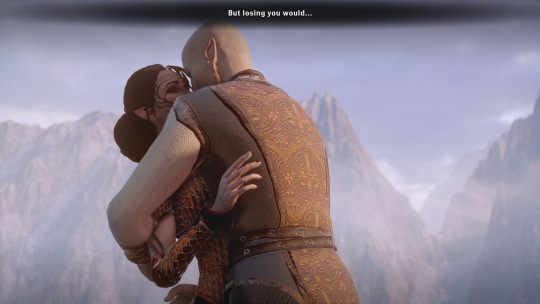
*since first posting this I have edited it to be a bit more streamlined and removed some redundancy.
#solas#solavellan#dragon age inquisition#lavellan#dragon age veilguard#solas x lavellan#love hot messes#OldDAArchives
128 notes
·
View notes
Text
i disagree with the idea that solas was once wisdom but was twisted into pride. not only because solas has always been called solas (pride) but also the fact that pride has many different facets and he has represented all of them.
using spite as an example. spite is called a spirit of determination by those who can sense or know his nature. he has chosen the name spite because spite is, in the end, still an act of determination it is just determination fueled by anger. spirits themselves when 'twisted' beyond their nature, aren't twisted beyond what they can already do or past their state of being. they simply become a different aspect of that being.
wisdom, in inquisition, does not like being in the waking world and has no desire to walk the waking as people do. when she is summoned and bound to obey those mages, she is still 'wisdom' but her nature doesn't change from wisdom to pride. she knows how to hurt others, even when she doesn't want to, and causing that harm, having that power over others, fuels that twisted aspect of pride. essentially, she is wise, she knows how to harm but chooses not to, when forced to do so she becomes prideful of the wisdom she has that she can do these acts of violence.
so, in regard to solas. he has always been pride, but pride is not necessarily a bad thing nor is it all the same. there's pride for others, pride for oneself, pride for accomplishments and pride for one's culture. so what is solas?
he is personal pride. not self-importance (not yet) but self-respect. every time the inquisitor gets approval from him--hell, even when rook gets approval from him--it's from having self-respect and trusting themselves. to know themselves and push forward to lead. it's why he hates slavery. what goes against the pride of self-respect? when the self is ripped away.
this is why him bowing his head to mythal is incredibly important because he is humbling himself. he respects and loves her enough to bow his head.
but anyone he sees as not having that self-respect? the first example is the qunari, whose culture is made primarily of followers. the tamassarans choose their jobs, their livelihoods, who they marry (if at all), where their children go, etc. he does see them as little more than beasts because, in his eyes, the people who follow the qun have no self-respect to think for themselves.
this is especially true of the dwarves. he has NEVER seen the dwarves as actual free thinking people. this is shown in his conversations with varric, when solas tells him that the dwarves are nothing more than a twitching, amputated arm. the titans were the people to him. the dwarves were cogs in the machine. nothing more than little workers who had no sense of self and who obeyed the titans.
does solas want to be wise? yes. i very much think that he does. i even think that he considers himself to be wise. but it is always colored by his nature of being prideful enough to never bow his head.
and in order to be wise, you must humble yourself.
51 notes
·
View notes
Text
inspired by the poll about theron shan's romantic chemistry with each of the origin classes, i wanna pose a somewhat similar question because i love thinking about it. it's a big thing in the swtor fandom that people tend to write relationships between their mains of each of the origin stories, and certain trends/combinations tend to be common - namely, sith warrior & jedi knight, jedi knight & jedi consular, sith warrior & sith inquisitor, etc.
so an open question i'm putting forward for anyone to reply to is what are your favorite pairings of classes - platonically, romantically, secret third thing, antagonistically, etc. you don't have to name an "underrated" one, but my question is based more on the chemistry between the classes, like, in general as opposed to specific iterations of that class. i.e., by all means use your OCs as an example of why you like that pairing, but like. i am talking more broadly about archetypes than specific characters. does this make sense. anyway, some of mine:
sith warrior & jedi knight
you knew this one was coming. i think the SW and JK are positioned pretty well to act as foils to one another, and there's something very interesting about how the transitions between Chapter 2 and Chapter 3 of each campaign mirror each other, with the finales of their respective campaigns leaving them on opposite sides of a current or future antagonist - with the SW ending up on that same side as the JK by ziost. i've interpreted this as a shared sense of personal responsibility - through their actions, one way or another, they make the most sense for being the emperor's number one enemy, which may lead to a sort of alliance between the two characters, depending how you spin it. or, hey, maybe your sith warrior is actually loyal to the emperor even still, at least until they are ultimately betrayed by valkorion. in which case, lifelong, bitter enemies. where maybe they should've had a common cause, maybe the pieces should've been there all along for them to fight together, but against all sanity and reason, the SW chooses again and again to stand by vitiate/valkorion.
sith warrior & imperial agent
next to SW&JK, this is the dynamic i keep coming back to over and over again - there's a reason why taizi's met most of @tiredassmage's agents. it's also the one i have the hardest time explaining why i like so much. there's the appeal of like ... hypercompetent pairing with vastly different skills but very good at those skills. it's kind of like a variation on what scratches my brain about SW & quinn in that there's a lot of toying around you can do with sith/imperial power dynamics - made even more interesting depending on the type of agent you're playing, and regardless an agent who has had their literal brain fucked with by the dark council, i.e. the castellan restraints.
sith warrior & jedi consular
listen. have i actually gotten to use this one much in the "playing blorbo barbies with my friends" sphere? not exactly. it's a very new one that i'm still rotating, and i don't know how to explain what it is i like about it but i really, really want to see more of it. i think it could be delicious, brent. please let your warriors and your consulars talk to each other more. one thing i will put forward is i think SW & JC scratches a similar itch to SW & JK to me, but in, like, a slightly different font? i dunno, man. i just wanna see it more.
honorable mentions:
jedi consular OR jedi knight & trooper: it's like jedi / clone trooper but without the ethical issues and cognitive dissonance! /lh
sith inquisitor & jedi consular: could be taken so many different ways, i just don't think enough about SI to do much with it
imperial agent & jedi knight: only really seen a few iterations - two of them being my own - but like. something in here's really fucking good.
37 notes
·
View notes
Text
I mentioned before that I think DA2 is perhaps the most appealing to me for a Time Travel AU. This is in part because Hawke as a protagonist doesn't have to worry about an impending apocalypse in the same way that the Warden and the Inquisitor do, so there's arguably more space for slow-moving character work, and I think it would be fun to explore Hawke's relationship to Kirkwall.
You can take Inquisition-era Hawke, sacrifice them in the Fade, and then handwavy magic happens there that sends Hawke back for a Time Travel Redo. (If it's irrelevant to the rest of the story, let's skip going into depth on the time travel method! It does not matter!) If you want to avoid time paradox concerns, given that time magic actually exists in this series, this can actually be a Dimension Travel AU as well, sending a Garrett Hawke back in time to another dimension where there's a Marian Hawke instead or something. Two Hawkes!
I prefer sending a mage Garrett Hawke "back" into this alternate dimension because he is absolutely going to look like his own father, Malcolm, to the young Hawke family trying to escape Lothering. And that's some delicious angst.
Another reason that I think Hawke in particular would be interesting is that I think it would be interesting to have a time-traveler (dimension-traveler) be upfront about what had happened to them. A tired Garrett Hawke reveals at least the basics of the "future" to his friends and family (all of whom are strangers to him and it hurts) because he wants to keep them safe, and then the butterfly effects of canon divergence ripple out from there.
There are so many time travel fics where the protagonist confides in no one or only does so very late in the story. There are often reasons for this. 1) They will not be believed. 2) They are surrounded by enemies. 3) They are focused on changing a very specific event and do not want things to change before that. 3.5) They are unwilling to share their knowledge and give up some measure of control over the future. (These control issues are often in-character!)
Sometimes, I am persuaded by these reasons and find them compelling and sympathetic. Sometimes, I find the protagonist's insistence on doing everything alone frustrating and even cruel.
I think that if Hawke had the chance to do a Time Travel Redo, it would be incredibly cruel if they did not at least TRY to share some of their knowledge with their companions. I don't think Hawke's companions would believe them immediately, of course, but they live in a world with strange magic. If Hawke was willing to be calm and vulnerable, they could at least give their future friends some potential leads in their individual quests (being open about the fact that this world may be different to their own).
Like, let's look at Fenris. Fenris would not trust some strange mage talking about fucking time magic, of course. But after knowing each other for a month or so, Hawke might be able to approach Fenris and say, "Hey, I have a really weird story to tell you." And then Hawke could share what they know about Fenris' past according to their own world, so that Fenris can maybe look into that and prepare himself. Because keeping that information away from Fenris is a dick move! Fenris deserves to be able to decide what to believe, what to investigate, and what to do for himself.
I also don't think I could suspend my disbelief if Hawke let Anders and Justice just... play out again over the course of years. I think most Hawkes wouldn't be able to resist confronting Anders in some way! Even Hawkes who end up saying, "I'm going to personally murder Meredith this time." Is a mage-friendly Hawke just going to let characters like Karl Thekla be made Tranquil and be killed again?
Do Merrill and Isabella and Varric and Aveline not deserve to try and avert some of the tragedies in their own lives?
Like, it is totally reasonable for Hawke to be focused purely on their own family or the companions they like, rather than try to save every person in the city. I think it's more than fine if there are tragedies a protagonist just doesn't care about averting. Hawke is not even going to remember everything.
And it is VERY normal for people not to want to give up some measure of control over their lives, especially someone as traumatized as Hawke. I do often find it realistic that a lot of time traveling characters in fanfiction are kind of "control freaks" who don't want to be vulnerable, even if it's "safe" to be. I'm imagining that this future-sharing from Hawke would stem in large part from 1) exhaustion, 2) loneliness, and 3) Hawke being used to celebrity, due to the "Tale of the Champion", and somewhat blasé by this point about all the fucking shit they've been through.
And I think that spilling everything (or even just the basics) would not necessarily go well for a Hawke. I think Varric would take even limited information about Bartrand's future very badly. As strangers to Hawke, I think all of the companions would be upset and disbelieving. (I'm currently imagining a mage Garrett Hawke who previously romanced Merrill, so that he and Past!Fenris were barely friends, because Fenris didn't like this mage Hawke hanging out with a blood mage and Hawke kind of thought Fenris might turn him in to the Templars someday. Past!Fenris was more Isabella's and Varric's friend.) I think these new companions might go on to make some BIG mistakes trying to avoid the future that Hawke has described, as much as they might avert tragedy.
I also imagine that Hawke's relationship with this new Hawke family might be very strange and awkward, even if both Carver and Bethany live. Garrett looks like Malcolm and everyone thinks it's weird; Leandra is probably the happiest and most practical about it, but Garrett can't forget how his own mother died horribly and also blamed him for his own Bethany's death. Neither Garrett nor Marian know what to do about each other; Marian doesn't like some new person waltzing in and taking control of situations. Garrett unconsciously treats this Carver as older and Carver loves it, but Marian doesn't like it. Bethany likes having a mage sibling, but Garrett is awkward because he's used to Bethany being the Hawke family's perfect dead sister. And Leandra's shitty brother is not fucking helping any of this!!! And what's that about Leandra maybe getting murdered by a serial killer in the future???
By saying all of this, I mean to make clear that I really don't think "communicating" would immediately fix every problem for a perfect "Time Travel Fix-It". I do think it would fix SOME problems. Emotional conversations and immediate canon divergence also appeals to me because I like reading those things.
What I mean to make clear is that I think it would be fun to write something that explores autonomy, authority, agency, and control. There are many issues in the world that stem from people unwilling to give up control of a situation for a variety of reasons, and other issues that stem from people believing they have the authority to dictate other people's lives.
What right would a new Garrett Hawke have to withhold information and try to manipulate all of their strangers' lives? Especially from people like Anders and Fenris, whose stories are so deeply concerned with freedom of choice? To conceal backstory information from someone with amnesia, like Fenris, is a choice, and I think it's a cruel one, even if Fenris might not like what he hears and might react badly. Can Garrett Hawke really claim that he "knows best"? What if he doesn't know what's going on with this version of the world? What do you do when freedom means standing back and allowing some of the people you like and love to make "bad" choices?
Some time travel fics seem to me to be incredibly lonely. The protagonist trusts in no one. The other characters can be written as predictably following a timeline to the point of being shallow caricatures of people. It's just not to my taste.
It could be nice to explore Hawke finding new sides of companions that they missed in their previous "run" (which was very much not perfect and full of strife). It could be nice to explore an exhausted Champion learning to trust in other people and have them step up to help solve these shifting problems. DA games are so much about making choices for everyone around you: on behalf of your companions, on behalf of entire kingdoms, on behalf of the entire world. It might be fun to explore an exhausted older Hawke giving up some control and being pleasantly surprised on some fronts as paths diverge.
82 notes
·
View notes
Text
Another return to old writing. Ayliel meets her uncle Roboute for the first time. It goes better than she feared.
Ayliel takes a deep breath, trying to center herself. It’s been a long time since she has been this nervous. She’s never been to Macragge before and she has no idea how Roboute Guilliman will react to getting a niece he didn’t know he had. Part of her wants to go back to the Rogue Trader ship and stay there. But the possibility of having family will always make her wonder what if.
Coming to Guilliman’s office door, her violet eyes widen in surprise. There are two very familiar golden armored giants flanking the door. For a moment she’s almost back on Terra. As if she opens the door her beloved grandfather will be sitting in his lab as usual, drawing up schematics for his newest invention. But those days will never come back. No matter how much it makes her heart ache at times.
Ayliel’s voice isn’t entirely steady as she addresses the two Custodes. “Darius, Set, it’s a pleasant surprise to see you here.” Darius shifts his helmet in the way that usually indicates he is smiling. “Likewise, Lady Ayliel. It has been far too long. Are you here to stay?” He sounds happy at the prospect. Set seems no less jubilant.
She returns the smile. “I just might.” Frak, she’s missed the Custodes. They have been a part of her life since she was born. Not many people can claim that they had diapers changed by the Custodes.
Set leads her into the office, announcing her to the tired looking giant seated behind a massive desk.
There is no doubt in Ayliel’s mind that this is her uncle. The family resemblance is undeniable, if you ignore coloring, which you should do anyway.
They both stare at each other for a long moment.
Roboute can’t find the words. She looks so much like his Father, for a moment he thinks she might be an unknown sister. Or the Emperor in disguise. But then he notices her eyes. Last time he saw eyes like that they were looking at him with hatred. On Calth. They’re definitely Lorgar Aurelian’s eyes. He shoves down a grimace. That’s not her fault.
The expression could not be more different. She looks concerned and nervous. And…lonely. He knows that feeling intimately.
So Roboute stands up, rounding his desk to greet her warmly. It feels like he really needed to stand up, too. He sits too much.
“It is good to meet you, Lady Ayliel. I’m surprised I have not heard your name before.”
She gives him a rueful smile. Something the Emperor never would have showed. “I’m afraid Grandfather kept me rather isolated.” Oh, of course. That tracks.
The Emperor, he doesn’t want to call him Father right now, was always damned secretive.
Roboute squeezes her arm in greeting. . “That sounds like Him indeed. You don’t happen to know anything about paperwork?” He gestures at the piles filing his desk. She steps closer, eyeing a pile while worrying at her lower lip.
“I’m pretty good at finding dodgy paperwork, would that help?” Ayliel finally responds, picking up a sheaf of flimsy and leafing through it. “Having worked for a Rogue Trader for centuries, I’ve seen a lot of attempts to pull a fast one.”
Roboute breathes a sigh of relief. “That’s perfect, mind helping me out?” She chuckles and starts sorting papers. The Custodes watching in mild confusion.
Ayliel can feel herself relax. She can do this. Her uncle needs help. That was obvious from the moment she saw him. He looked more tired than an unsanctioned psyker who has spent a month on the same ship as an Inquisitor.
#warhammer 40k#warhammer 40k oc#primarch children#oc: ayliel of colchis#my writing#primarchs#roboute guilliman
25 notes
·
View notes
Text
It itches my brain, fam, because I can *see* all the perspectives and philosophies. If he leaves well enough alone, he is forsaking the ancient elves and condemning their society to utter extinction. He has the ability to fix things (supposedly) and simply accepting things as they are is like getting away with murder with a “sorry”. But if he does try to change things, he is condemning an entire world to death. He is trying to wrench the past into the present, trying to resurrect an empire. Even though he hates imperialism and empires, that’s what he’s doing.. He is trying to replace those alive *now* with those whose existences are *potential*. He’s trying to bring back people who lived during a time of great splendor and eminence. In essence, Solas wants the ancient elves to *replace* those who are presently living. He doesn’t get into what this means for humans or qunari or dwarves (the latter existed during ancient elvhenan). Can we be sure that the ancient elves would resist exerting superiority/supremacy over the remaining living people? Can we?
As far as I understand. I still don’t understand what he means by bringing back the Ancient Elves. If he means that there are ancient elves in comas he wants to resurrect or souls stuck in the Fade he wants to give bodies? Or he means the few elves like Abelas that are still alive that he wants to return their pre-Veil powers to. IT’S REALLY UNCLEAR.
The reason WHY I am so furtive about the Veil is because so many important details are left unknown. In a conversation you have with him in DAI on the balcony, he tells you to your face you flout the categories he has created for the different races, and this is him as Wisdom-Pride given mortal form. I cannot shake the nagging worry that the Ancient Elves, if they were to return, wouldn’t reassume a collective sense of racial superiority over the surviving living races. If they truly get their resurrected empire off the ground, I can 100% see them marginalizing the modern elves, dwarves, humans, and qunari. Everyone would be “separate but equal”, and not even Solas with his good intentions and “philosopher king” pursuit of freedom would be able to prevent it. If the ancient elves were to get their shit together, some form of organization would need to be arranged, and like Elgar’nan, it could lead to a consolidation of power that recreates oppressive hierarchal structures. Solas would probably take up the mantle, reluctantly, but for all of his desire that rulers cede power when they are no longer needed, he would have to remain a ruler if only to prevent war lords and ambitious ancient elves from pulling another elgar’nan. He would either need to become the thing he detests, watch the ancient elves make the same mistake as before, or watch the ancient elves wither away and die before their society ever had a chance to see its true birth. Just because the ancient elves were slaves and freemen who suffered under the tyranny of the Evanuris doesn’t mean that their suffering will make them nobler or more insightful and more sensitive to the harm they could inflict on the survivors of the apocalypse. Because it would be an apocalypse.
But again I need details on how Solas’s plans allow the ancient elves to come back and exactly how many people will die if they were to go off without a hitch. We talking 25%? 50%? 75%? 80%?
I want to live in a world where it is possible for there to be a Legend of Korra style Harmonic Convergence where spirits and people can mish mash together with minimal death and bloodshed. Where the hell is that option. Yes it’s very neat and tidy and “happily ever after” but I don’t care, make it one of the most difficult and intricate world states that you need to do a fuckton of things to be able to trigger! Have your Inquisitor and Solas be the sacrifices needed to make that happen so that you still get that bittersweet tragedy, crib the “Shepard is Spacedust Spacetime God” for it, idk! Make a dozen different endings, if you want.
Veil comes down (Inquisitor dies)- Inquisitor dies in attempt to prevent it. Thus Solas wins, but it’s a pyrrhic victory because it is the final piece of his humanity he has sacrificed. He rules as a stone-hearted king. Romance version: Solas has once again lost a world he cherished. His heart.
Veil comes down (Solas dies)- Solas dies to ensure it does, believing the world is better without him in it. The final sacrifice. But without Solas to lead the ancient elves, his efforts are all but wasted. They cannot gather together to rebuild and meanwhile every other kingdom and empire is crumbling from the shock of the Veil torn down. The world is on fire and demons are everywhere and oh my God what the fuck. This is the worst ending.
Veil stays up - Inquisitor dies to keep it up and things end up in such a way that Solas is incapable of ever interfering with the Veil again. His punishment is to live in this world created by his actions, divested of power, neutered.
Veil stays up (Romance optional: Stop Solas) - Solas somehow, either voluntarily or involuntarily, sacrifices himself to keep it intact. Essentially the “Good” and “Trick” DATV endings.
Veil stays up (Romance optional: Stop/Save Solas) Solas abandons his desire to tear down the veil. He accepts that trying to change the world is not worth it because this world is also worthy of life. Solas is basically put in Inquisitor’s/Lavellan’s custody. One can choose whether to imprison Solas, Tranquilize him, kill him, or task him with helping make the world a better place.
Veil comes down (Romance-Save Solas) - By some means, Solas and Lavellan sacrifice themselves to bring the Veil down safely. LoK Harmonic Convergence. It is more difficult for the world to adjust. Solas is not there to lead the ancient elves, Lavellan is not there to help unite modern people. It’s a brave new world, for better or worse. Underlying theme: We have to believe and hope that people will strive to make the world better.
Veil comes down (Romance-Save Solas) - The rarest and most difficult achievement. Solas and Lavellan survive and the Veil comes down. They are there to lead their worlds toward integration and coexistence. They live happily ever after. I don’t know what big sacrifice needs to be made for this to work. Perhaps Solas completely loses his magic? Perhaps he also loses a limb. I don’t know, fam.
Anyone got any other ending ideas?
I’m just talking aloud and getting my thoughts down. Pay no mind to me. I have never claimed to be good at writing stories.
28 notes
·
View notes
Note
MW!Rook: I never took advanced classes. Got too... busy.
Now I'm intrigued by the thought of a Rook who ends up deciding to continue their Watcher studies after defeating Elgar'nan and Ghilan'nain, taking the advanced classes and realising that Emmrich Volkarin himself was to be their professor in advanced necromantic arts. Imagine how awkward that must be, trying to maintain a sort of professional distance with a man you saved the world with???? Who you have
Also on a semi-related note-
Just imagining the aftermath of defeating the gods if you chose Harding to lead the other group and just... the Veilguard ends up having some grand celebration for it (with nobility involved because of course they want to have a piece of the pie, to say they were involved, just like the Inquisition after defeating Corypheus)
And Cassandra is there. Maybe Leliana.
And one of them is most certainly pissed at Rook for letting three Inquisition members die. Dorian tries his best to smooth things over, and Rook just feels so, incredibly guilty over what happened. Nothing they say or do will ever make it better, will never change the fact that they lost Varric, Harding, and the Inquisitor all at once. And these were their closest friends.
I feel like it's Josephine or even the Iron Bull who tries to comfort Rook, to tell them that it wasn't their fault (though Iron Bull would be more along the lines of 'they died a warriors' death' sort of thing)
I honestly love that idea. I mean, let's face it, it makes perfect sense MW! Rook in this universe wouldn't have time to devote the study needed to join the more elite Mourn Watch ranks. Even from their talks with Myrna ("Back straight") and Emmrich saying Rook has "advanced adequately", I very much get the vibe that Rook's studies are not their strongest bargaining chip.
But hey, between the War of the Banners and two blighted elven gods, who has the time?
But then, you dive back into your studies after a little final boss-reprieve only to find that your beau is your handsome professor. Unlike Johanna's arrangement, this one is a favorable one. Needless to say, many lessons are tentatively guided with should squeezes, intimate guiding of the ceremonial hand gestures ("raise them higher, darling, just a bit more for me...") and ... desk sex. I don't know if Em could SWEEP everything off the desk like Cullen though, haha. ("That chalice is a relic from the Storm Age! Here, let me put it over here.")
Ohhh, yeah. Harding's death would hurt. Dorian, of course, tries to swoop in, but that's not enough. Same with Varric, even though Rook really can't be blamed for that one. OH GOSH, imagine losing the Inquisitor too. CULLEN, MY MAN. ;;
Leliana and Cassandra ... it would be hard, but they would know their leader did what they had to do. They could honor that, I think. Cassandra would cry, I think. In secret, of course. That was their best friend.
Inky's spouse/lover? MUCH more pissed. Now THAT is a confrontation I want to see - very bittersweet.
I can see Josie doing it (Emmrich and Josie actually have the same writer, so it's poetic that it's her). It just suits her personality so well. But I LOVE it being Bull as well.
"It's hard to lose good men, but they chose to fight. Be proud that you rallied a team that believed in you that much. Who stuck their necks out. That doesn't come around every day."
Some extra Trespasser foreshadowing with that. Just a smudge.
20 notes
·
View notes
Text
A Veilguard Achievement Icon Opened My Eyes on 15 Years of Lore... but Was I Right?
PART TWO: What Veilguard Did Narratively, and What That Tells Us Going Forward
[ 1 ]
Hello again, friends and travellers. Now that I've beaten Dragon Age: the Veilguard, I wanted to go through all those 30,000 words of predictions that I wrote in the ~11 days leading up to its release. I'd seen an achievement icon that pieced together a lot of Dragon Age lore for me.
But, I hadn't played Veilguard. All I had was the footage from September 19, the achievement list, and anything else BioWare had released.
So... was I right? And if so, how much was I right about?
This is your warning:This post will contain spoilers for the entirety of Dragon Age: the Veilguard, and all Dragon Age content made before Veilguard.

(my davrinmance is going great as i try and collect every codex, thanks for asking!)
Today's Discussion: to Understand Dragon Age, We Must Understand Its Writing.
Before I can go any further on why I think the way that I think, or why I imagine the story might take us in certain directions, it's essential that you all understand where I'm coming from. Veilguard, like any game, is a piece of art. Its bones are built with similar narrative structures to novels (though not identical, and that's important!). To make sense of what's to come, we must examine Veilguard's bones the same way.
I've seen a lot of people wondering why, for instance, the Inquisitor is not Veilguard's protagonist. I've seen people lamenting the fact that there were not on-screen clarifications of popular lore theories. Before this series goes any further, I need to say my piece about why I believe that it was essential that Veilguard was written as it was, and why its writing does in fact help us better predict Dragon Age's path forward moreso than even Inquisition.
That said, today I hope to cover:
What Veilguard Demanded of BioWare's Writing Team, and Why
The Protagonist: Why Rook's Perspective Matters
The 3 Act Structure: Our Lens
The Companions: Paths to Our Answers — and Future Games

What Veilguard Demanded of BioWare's Writing Team, and Why
Let's get this out of the way right away: it has been 10 years since Inquisition. And, like it or not, that means one gigantic thing for BioWare: if they wanted to have any hope of making more Dragon Age, they needed to bring in new players and resuscitate the interest of many old players who did not stay in the fandom the whole time. They didn't—and couldn't—write Veilguard specifically for you or I, people of Tumblr. If they did, it would've pleased us... and then cost them so much money that we'd never get any more Dragon Age.
That doesn't just mean modernizing the game's aesthetics, or providing a glossary in its Codex. It means they would have to balance all of the following (just at a glance):
Managing the learning curve in general. Not even I looked in the glossary as I played. Me, supreme enjoyer of all codices ever. It's just not something most players are ever going to do, as much as it the lore is such a fundamental part of the game in general. That means simplifying terms where possible — elven gods in place of Evanuris, for example — but also trimming down what would have to necessarily reference past games. Only a tiny fraction of the fanbase has played Inquisition in the last 3 years, nevermind this year.
Recontextualizing the lore. That does not mean rebooting it, it means situating all we have learned so far in a framework that fits all we have learned so far. Much of what we learned about the Evanuris seemed, for so long, to be totally separate for the things we knew about the blight and Blights. Veilguard needed to show us how those things relate, and to do so in a fresh context that would allow everyone to develop new understanding.
Pushing us one step past Inquisition's knowledge. Veilguard, after reframing the lore, had to leave us a path for new lore, and increased understanding. I think the devs put it really well when they say that their aim is to give us some answers, but leave us with even more questions. More on that later, and in future posts.
Updating Thedas' ethos. Let's face it. It has been 15 years since Origins came out. The things that were more typical of scifi/fantasy (SFF) then are just not the same now, and would not be perceived by 2024 players in the same way as by those who started Origins in 2009. The world has changed; our cultural understandings are broadening and need to continue broadening. BioWare is doing a good thing by incorporating things like nonbinary identities into Veilguard, and it is good that Veilguard is progressing the world of gaming in that way, especially considering its success. (This is also, I wager, why we choose an Archon out of two choices who want the same thing, rather than leaving that open to a more "evil" option).
Dislodge older fans from their Solas headcanons to get everyone old and new to the same confusion and potential distrust. Hear me out. Everyone who's stayed since Inquisition has beliefs about Solas. Even me, who got here in March of this year, whose fic reads overly soft now because I just didn't know Solas' grander plan until 48 hours before Veilguard came out. Everyone has had headcanons for so long that everyone has had time for their opinions of Solas to cement themselves. In order for Veilguard to work as a story, they had to debunk what everyone thought they knew: both lovers and haters of the famously controversial egg. By breaking down our existing beliefs, the devs open up essential curiosity from the players as to who—and what—Solas really is, which propels us through the narrative and has us absorbing information.
And this curiosity? It is why Veilguard could not have the Inquisitor as its protagonist. To keep us curious as players (and "readers" of the lore), BioWare needed a new protagonist.
Specifically, they needed Rook.

The Protagonist: Why Rook's Perspective Matters
Here's the thing. The protagonist is not just the face of the game. They are our vehicle to understanding that game. The plot follows their wants and responds to their understanding. What they don't know, what they want to know, is what makes up our every objective. Their emotional journey through the game is our emotional journey through the game. Following it, going after the things that matter to our protagonist, is how the entire game (including its lore) takes shape in our minds.
That's why it's essential that they don't know everything—especially after a ten year interim between games.
Veilguard's plot and twists proved that the Inquisitor did not know everything. They, in fact, knew less than half of everything. If we had kept them as the protagonist, all of our knowledge and curiosity would be shaped by the Inquisitor's understanding: a wrong understanding. We could constantly be fighting with what we think the Inquisitor should know, what should be true because we had seen it through the Inquisitor. We would be set up to be at odds with the very events of the game. Rook is a blank slate, barring a few key tonal indicators, and that blank slate allows for us to fit all previous lore into its new, recontextualized shape that I mentioned above. (Again, note that I am not saying rebooted.)
That, and Rook has multiple motivations. The Inquisitor is focused largely on stopping or saving Solas; Rook is charged with figuring everything out as it is happening to them in real time with almost no context or experience, AND stopping or saving Solas. The Inquisitor has existing allies and resources; Rook does not. Rook must build their own campaign from the ground up, and that means the player is building their own experience from the ground up. Their allies, abilities, and home base, yes, but also their knowledge. Discovering things at the same pace as Rook, with a similarly urgent drive to do so, keeps the game from infodumping at us. It keeps the reveals evenly spaced, but also immediately interesting to the player.
And best of all? Rook allows the writers to do what they want to Solas without breaking his dynamic with the endless sea of Inquisitors (or, at least, with way less risk of doing so). We needed to have our theories about him broken down and rebuilt as players; to do that to the Inquisitor would damage an entire sea of headcanons. We'd never get the Solavellan ending we wanted, for instance, if Solas had played mind games with Lavellan for that many months. And if Solas didn't do those things, if he'd been wholly defanged, he would have lost his appeal and importance in the narrative. He wouldn't be the Dread Wolf in the ways that matter to Veilguard.
It's important, then, that Rook has just the slightest bit of backstory. They care about their allies. They are not a potential political force like the Inquisitor. They have many options to be impulsive. Every single Rook has rebelled against authority. Every single one has a stubborn streak. BioWare put all those qualities there on purpose, because Solas uses every single one, in every single Rook, as a tool. That was all essential for his character development in this game! At the same time, they couldn't do that with the Inquisitor as protagonist, because after 10 years, no two Inquisitors are similar enough to predict/script their actions and responses in that way.
Those twists are perhaps the most important tool for forward momentum in the game. The more they keep us guessing, the more we'll play and seek new information, the more we'll learn. Which brings me to...

The 3 Act Structure: Our Lens
Like I said: BioWare couldn't just infodump at us in Veilguard. It wouldn't be interesting to even half the fans that stayed, these ten years. To keep us engaged as players, they had to string the lore through a series of engaging events. Keep the momentum up, so we would not be lazily looking over codices, but chasing new knowledge and understanding. It all had to be emotionally relevant and resonant to keep us caring, because very few people play games they don't care about.
Veilguard, like a lot of written art, follows the three act structure. Though there are a lot of variants on the more precise beats, they all broadly follow the same-ish path.
Hook: The opening image. In Disney movies, this is the song where the character sings about all the things they want in their journey, and what they truly need is only implied. It gives an opening note for the theme by showing what the character lacks, and what they might need to gain before defeating the final villain. In Veilguard, this is our prologue, centered entirely around Varric: the big red herring where we see that Rook is out of their depth, opting to push over a support beam rather than take on the Dread Wolf. Off-screen, it is also the background information about Rook, showing us who they are and what they want before we play.
Inciting Incident: The event that kicks off the main plot. In DA:tV, there's a big collection of these (because every companion needs one; we'll get to that). The first big one is, of course, the failed ritual. The death Rook doesn't see. The Evanuris are freed, but Rook has only half the information.
First Plot Point: "Plot Point" means "big/defining decision" in writer-speak. This is the moment the protagonist decides to go forth on their adventure. In video games, this is more or less determined for you, but you have the option to flavour this moment in Veilguard. You can choose how to tell Solas that you'll do what he wants: either by appeasing him or angering him. You do the same for Neve and Harding afterward, and then again in Arlathan and D'Meta's Crossing. You state that you're doing this, no matter what it takes.
First Pinch Point / "The Setback": "Pinch" means "twist" in writer-speak. It's the first time the narrative is shaken up, and is also usually the first time we see the true scope of the villain. In Veilguard, the first big twist has been called "the Setback" by some of the devs (notably, I heard it at a panel in September). For Veilguard, this is Weisshaupt. We see the true scope of Ghilan'nain's horrors, but we also see the first BIG hints (outside of Varric) that Solas is manipulating us—because he really doesn't seem to hate the Wardens as much as Inquisition enjoyers like myself expected. This event concludes act 1.
"New World" / "Fun and Games": The devs have remarked that they wanted to see the tone of their setback (Weisshaupt) threaded through the rest of the game, and we do: through Davrin and Lucanis' banter, through the reflections on the consequences of Weisshaupt, through every character struggling with their confidence and identity after that point, through the blight getting worse and worse and worse. That's what the New World is: the characters getting used to new circumstances after that first big twist. The Fun and Games are the slow and steady recovery from the twist, warming and solidifying formerly tenuous relationships. This is where we do a lot of companion and faction quests.
Midpoint: In a narrative that ends in a victory (so most games ever), the midpoint is a false victory. We think we've nailed something, only for something else to happen that begins to seed doubt in the protagonist's capability and/or ability to solve the plot. For Veilguard, this is the blighted dragon fight: we think we've got Ghilan'nain, but then Elgar'nan shows up and demonstrates that Rook is in so, so over their head.
Second Pinch Point: The second twist. The villain's identity is crystal-clear, and by now we've definitely interacted with the villain more directly. This is Arlathan, Elgar'nan's mind-trap—and Solas' "rescue" of Rook, showing his duplicity in full. Elgar'nan notably says a line about not falling for Fen'Harel's tricks again, and it foreshadows what we will see of Solas.
Disaster / Crisis: This is the event that triggers the protagonist's downward spiral. Not a twist (necessarily), but a catastrophe. In Veilguard's case, it's both: the Ghilan'nain fight leaves one companion dead-dead and another presumed dead. Then, the twist: Solas using Rook's sharply felt regret to pull his gambit and swap places with them. A series of events that literally had me gasping so frequently I got dizzy. Thanks, BioWare :) Many people say that this event, or something between this event and the "All is Lost" beat, conclude act 2. For games, the pacing is sometimes different, as is the cutoff mark, because otherwise the third act has the potential to be very short.
"All is Lost" / The Dark Night of the Soul: It's exactly as the name suggests: all has been lost. The protagonist doubts themself completely. It seems like nothing more can go wrong, and like nothing might ever go right again. The protagonist is at a loss for how to move forward. In Veilguard? Varric is dead. Davrin/Harding is dead. Bellara/Neve is dead. Rook is literally trapped not only in their regret, but in a reflection of Solas' regret. And to get out, they'll need...
"The Epiphany" / Second Plot Point: "Plot point" means "big/defining decision" in writer-speak, as stated above. Only this one contains more layers than the first. This is where the thematic statement of the piece comes out: the lesson that the protagonist must learn is stated, clearly, for all of us to see. It is the thing that picks them up off the ground, giving them strength to face the climax and the danger it promises. In Veilguard, this is Varric saying to Rook, "Have you learned nothing here?" and reminding both Rook and player that he chose this; Rook's companions chose this; we cannot blame ourselves for the actions of others. We cannot carry grief for other people, or we'll drown in it. Sound like any other character we know?
Climax: The big fight! But also, the big moment where the theme is shown to be the narrative key. In every ending of Veilguard, Rook being Solas' perfect mirror is the key to winning the day against the Dread Wolf. It just depends on what facet of Solas Rook chooses to mirror: the trickster, the nasty combatant, or the person who was haunted by their own failings and lost companions.
Resolution: Narrative threads are tied up, or a promise is made to tie up those loose ends in future installations. Veilguard's credits do both of those things. :)
Why am I telling you all of this? Because the lore must follow that skeleton. Every reveal we get must fit into both the timing and the feeling of those events. It would not fit to suddenly drop everything about the Titans right after Rook gets to the Lighthouse, which is why those enemies you need to kill to get the last memories are level 30-40. It would not fit to uncover everything about the blight's origin before Weisshaupt. If they forced us into that as players, all the casual fans and new players would duck out, feeling overwhelmed.
Even for us older fans, narrative structure shapes significance. You can tell a lot about a codex's overall importance and tone just by understanding where you find it, and when. That's why the Trespasser codices carry so much weight, even the ones about the Evanuris' actions that we don't see on screen at all: they are at the bitter end, and so they carry all the bitterness, longing, and mourning of that ending. Without the context of Trespasser, they mean less.
This is also why Veilguard paces its companion quests this way, not allowing you to complete them until later in the game. Every companion has something to teach us, and BioWare wanted to give each companion's narrative the weight it deserved.

The Companions: Paths to Our Answers — and Future Games
Anyone who's played Inquisition knows that companion quests shape entire facets of the lore in individual games, as well as set us up for the trajectory of the next games. Just look at Solas and Cole: together, they shaped our whole understanding of spirits in Veilguard. They set us up to ask all the right questions about not only spirits being bound as demons (Solas' quest), but about spirits being able to manifest in physical shape (Cole's quest). Together, their narrative conclusions foreshadowed much of the Evanuris' reveals in Veilguard: that they were spirits who could manifest into corporeal shape, and that they had the ability to ask others to manifest—and then bind them.
Again, these quests are paced throughout Inquisition's main plot. You cannot do their before Skyhold, and you cannot do them after the cutoff of (I believe) the Temple of Mythal. Inquisition forces you to see those quests' endings in the exact right spot: sometime around the midpoint (Adamant/WEWH), but before the disaster/dark night (the Temple of Mythal). They do that so you will feel that those things are significant.
Veilguard does the same thing. Every companion has a facet of the lore attached to it, but you cannot follow those threads to their conclusions at the beginning of the game. The game won't let you, because the moments need to be spaced out properly and carry the necessary emotional weight. Not all of their quests promise speculative material for future games in the same way, because some explain the context of the current game (Varric, in DAI, accomplished both with the red lyrium content, for instance; Leliana, meanwhile, dealt with the theme of faith in DAI and did not promise future speculation).
These concepts will all get far more attention in due time, but in short, here's what I think is associated with each companion:
Harding: Titans! But also, angry titans, and the difference between "angry titan" and "source of blight." In the same vein, what the dwarves should do going forward, and where they should place the titans in their culture.
Neve: The soul of Veilguard; her narrative is very current to DA:tV, in my early understanding. But she brings forth a lot of nuance to the themes of regret, and what that regret looks like on a smaller scale (a city, rather than a world). She does a lot of work in showing us that regret is regret, no matter the scale, and that the work we do to do better matters, no matter the scale. Additionally, her personal quest foreshadows Solas' use of blood magic against us being more than we thought by showing off Aelia's puppets, suggesting to us (tonally) that Rook may be Solas' puppet.
Bellara: The Forgotten Ones!! Anaris! Also, the place of ancient elvhenan in the future of Thedas, and what the elves should do/feel going forward.
Lucanis: I think they were going for some Forgotten One/Forbidden One hints, judging by some notes from the Ossuary and some banter between Lucanis and the others. This needs more dissection. Lucanis sort of does both what Bellara and Neve do: the Forgotten Ones, and also the heart of Veilguard's theme, with a lot of found family vibes thrown in.
Davrin: The blight itself, and the future of the blight without any archdemons left to cause capital-B Blights. Thedas' path to healing its nature.
Emmrich: The nature of what spirits are. I need to go screencap more specifics, but I swear this necromancer has referenced the difference between spirit and human soul and has stumbled upon saying that the two might not be so different at least once. Also, the Formless One centers around the Necropolis, and I'm thinking "spirits seeking bodies" and this whole idea of unlife/undeath is going to be explored later.
Taash: Remember how I said BioWare needed an ethos update? I think we see that most predominantly in Taash, whose entire personal quest is an examination of the values and priorities of different cultures, as well as the place of gender and gender ideology in Thedas. We saw this with Dorian and Krem in DA:I, but Taash modernizes that conversation (10 years has changed a lot!) and brings it front-and-center. At the same time, their existence is referencing (potentially) the Scaled Ones, and showing us that the kossith (Qunari) might have far more ties to Evanuris shenaniganry than we thought—and that those shenanigans did not happen on Thedas, but potentially far across the sea. (Neve and Lucanis accomplish this, also, with the Shadow Dragons and Crows, but not to the degree that Taash does).
This is why the companion quests MATTER, and (at least partially) why the game asks you to complete these quests or suffer consequences in the finale.
You know what else happens, upon completion of these companion quests?
You get codices. In Dragon Age, they are the threads that tie the seemingly disconnected pieces of the plot together, and that's on purpose. This time, they automatically unlock upon completing different stages of companion quests—and as far as I can tell right now, days after completing the game for the first time, the ones revealed later DO contain spicier hints about future lore than those revealed earlier.
And between ALL of these things—the demands Veilguard's timing placed on Bioware, the need for Rook as a protagonist, and the structure for every companion's quests—I think BioWare did an amazing, genius job with their narrative. Yes, I have seen some of the art book content, and yes, it would have been so cool to have those things, but... I truly do not think BioWare needed them, as close as I would have held cameos like Cole to my heart.
From a lore perspective? They knocked it out of the gods-damned park with Veilguard. They did an amazing job with each of their quests, and I promise: there is no shortage of juicy lore to be found in Veilguard. Now that I've inflicted an outline of what I know about stories upon you, I promise: all of this serves as context for everything I look forward to saying in future posts.
_____
If you got this far, thank you, as always!
This series is going to take a turn toward what I noticed in Veilguard, how I feel that Veilguard adds to my theories (or perhaps debunks some of them), and where I think the series is going to go from here. But in order to write all that properly and miss as little as possible (even though, in November 2024, with no wiki or transcripts, I am guaranteed to miss things), I need to keep playing the game and keep reading the codices I find.
Stay tuned for the next instalments, though I cannot say how quickly they will come after this. <3
#dragon age#dragon age: the veilguard#veilguard spoilers#da theory#da meta#solas#solas dragon age#evanuris#bellara#davrin#harding#neve#emmrich#taash#lucanis#da:tv#da:ve#dragon age: veilguard
59 notes
·
View notes
Text
Dragon Age: The Veilguard Review Pt. 2 - "How to move on?", On Solas & Rook
DA:TV Spoilers ahead!
Pt. 1 is here
Which brings me to Solas and Rook: how does Solas move on?
The fascinating thing about Solas is that …he doesn’t. He errs too much in both directions – he both takes too much personal responsibility and ascribes too much to systemic responsibility. How is that possible? I suspect it is because, and here’s the kicker, he IS the system, in his mind. “You were never ready to make the sacrifices that leadership requires”, he says as he betrays Rook like he has betrayed the Inquisitor, like he has betrayed Felassan, like he has betrayed Mythal. There is so much he regrets but in his memory, we do not see him regretting the acts (like severing the Titans’ dreams or the fall-out of the war) as much as the precursors, the moments where he failed to convince others of his own better judgement / was (arguably) coerced into making a choice or remaining passive (like taking a physical form; like being unable to convince the Evanuris not to become “gods” and conquer; unable to convince them not to use the Blight; etc.)
It makes sense: he is wisdom, but he is also pride. Being humble would require him to acknowledge the limitations of his power and influence; being prideful is what leads him to “…but what if?” again and again. It is the same rebellious stubbornness that leads him to oppose the tight grip and tyranny of the Evanuris, the same voice that whispers: “No. It could be better. I should have known better. I could make it better. I am wisdom. I know the way. This is why I took a physical form. This is my job. My failing.” Instead of accepting that his own power only goes so far; that he is only part of the system and not all of it, he instead runs against this wall again and again, thinking that it was an error in approach and strategy (and those can be fixed!), not in power and assumed responsibility. He IS the system; he just has to get the system RIGHT. “I must fix what I have broken,” indeed.
And this is where Rook comes in. When mourning him, Dream-Varric tells them: “Shit. Didn’t you learn anything from this place? /I/ made the choice. To talk to him. To try to reach him. (…) My decision. My sacrifice. And you don’t get to take that from me.” That is the vital lesson that Solas never learned: it is not all on him. The other Evanuris made their choices, and he was just one player among many. Each time his actions had unforeseen consequences, he tried to go back, fix it, and undo what had been done, on a grander and grander scale, rather than facing the consequences head on, forgiving himself, and working with this new reality. This is the lesson that Rook learns in the Fade Prison – “how do we move on”? By accepting the current circumstance for what they are, and letting go of the assumption that everything could be under your control if you had just tried hard enough (fitting for a protagonist whose biggest skill is “winging it”). There will always be other people, other thoughts, other approaches, and each person is responsible for their own decisions; you just for your own. Ironically, the sooner you accept that, the more power you will have – as can be seen in all the companions’ quests, and the “good” Rook/Solas ending. Solas: “The things that I have done…” Mythal: “Are not for you alone to bear, my friend. The many wrongs we did, we did together.”
This admission of guilt outside of himself; this owning up to responsibility, allows Solas, for the first time, to see himself as an equal player with others, not one who has failed to set the stage just so, and to leave his denial behind – to stop trying to fix the past so it all never happened – and to accept the consequences of his actions and move on. For the first time, he says “I will seek atonement”, not “I will fix my mistakes”. Whether it makes complete sense in-universe to leave the Veil where it is, I cannot say, but as an emotional truth, there is real pay-off to this: Solas accepts that the past has happened (really, fully, truly accepts it) and that it cannot be undone, no matter the trickery or blood and tears poured into the open wound. We must learn to live with and integrate what we have done and who we are, not deny or reject it as part of ourselves – that is the lesson learned in all the companions’ quests, and it is what Solas has now learned, too. For the first time in a long time, Solas believes in a future.
As it is, this is a beautiful story worth telling. But for two reasons, I cannot rate the entirety of Veilguard anywhere above 7/10. The first is Rook, the second the issue of community.
On Rook: like with Taash, I do believe that the ideas are all here. It is the execution that makes me a little sad. The idea clearly was to contrast Rook with Solas (which worked particularly well for my headstrong male elf Rook, which I loved – also shout-out to Alex Jordan, the male British VA, who absolutely killed it!), and to show that, by the end, Rook has moved beyond Solas’ self-imprisonment to become a true leader of their people. Cool. But where’s the arc?
All of the companions (and Solas) have to face something that they were afraid to confront in their own lives. What is Rook afraid of? I think the game wants this to be Varric’s death, and thus, the moment they accept that he is gone, he is able to escape the Fade Prison and defeat Solas. But WHY are they scared of Varric’s death? Again, I think the game WANTS this to be the burden of leadership but one of my biggest notes on the game is “burden of leadership where?”. For what I suspect were get-on-with-it game mechanics and time-constraint reasons, Rook clicks into leadership with complete ease (or at least my predominantly red/assertive Rook did – I suppose it feels different when choosing the teary-eyed responses?).
From the beginning, Rook is hyper-competent, never questioned in their position as a leader (why not Harding? Why not Neve? Especially since it seems to be dead-Varric appointing them?), and never falters under pressure. There is not one moment where I could say that Rook truly messed up and had to learn from their mistakes/accept the consequences of their actions. True, I did also play them as very competent and didn’t, for example, rush into the final battle without bolstering the factions and training my companions, but if this is an integral part of the story that every player should experience, it should be hard-coded into game.
Ultimately, Rook felt to me more like the platonic ideal of a character than a real person, which is a shame. Personally, I think this storyline would have lent itself really well to bringing back the Dragon Age prologues from DA:O – show me Rook messing up a mission (and let us really get to know the factions)! Let them start from the bottom up! Let them grapple with what it means to be a leader by constantly casting their mind back on what they have done wrong! Let them be an even stronger mirror to Solas!
Again, I think that the game wanted to do something like this with the Varric reveal and you “sacrificing” Davrin/Assan or Harding, but neither is actually Rook’s “fault” by any measure, and they come so late in the game that the Fade Prison sequence has to really rush you through the process of acceptance. Here, too, I would have loved more of a feeling of time passing by – it is the equivalent of the lost-in-the-snow scene in Inquisition (which I loved!), and just a bit more artistry would have really taken an already great chapter up a notch (e.g. show Rook’s vision blurring, passing out, coming to – “where am I? How long have I been here?”, show the surroundings cracking, seasons changing, Rook trying desperately to remember their friends, their system failing – “when did I last eat? Drink? Do I still need to? Am I dead?”, really driving home the thematic significance of the grieving process before ascending to acceptance – being haunted by statues appearing suddenly behind them whenever they turn, being thrown back into memories where the companions are washed out, etc. And let them REALLY grieve if they lost their love interest!)
That is to say: the other characters have to grapple – Rook gets to move on almost immediately. I also saw a tumblr post (which I unfortunately did not save; please let me know if you find it) that says that what was truly missing from DA:TV was a final scene in which the door closes behind Rook, job well done, and Rook just falls on their knees and all the pressure comes slamming down, and they break with a sob, a scream, or a laugh (with their LI or the whole team to catch them), and God, yes. The scene in Trespasser where the Inquisitor gets to actually lose their shit for a moment (“Shit! Damn it! We save Ferelden, and they’re angry! We save Orlais, and they’re angry! We close the breach! Twice! And my own hand wants to kill me! Could one thing in this fucking world just stay fixed!?”) solidified them as one of my favourite characters of all time; it made them feel real. Rook? Gets none of that. (And I say that, again, as someone who played a red/assertive Rook. He got to be angry plenty, but rarely every felt like he was letting us, the players, or his companions into the depths of his soul. Vulnerable? Insecure? That’s for the companions, not the capital-h Hero.) Unfortunately, that leaves Rook’s character development somewhat underbaked.
Pt. 3 is here
#dragon age#datv#dragon age the veilguard#dragon age spoilers#dragon age veilguard spoilers#datv spoilers#dragon age meta#solas#solas dragon age#rook#rook dragon age#rook mercar#dragon age veilguard critical#<- not exactly but just in case
23 notes
·
View notes
Text
"Jedi cannot help what they are, their compassion leaves a trail."
Obi-wan had to become callous to it. Tattoine may be the ideal planet for growing callouses. He had many now. Across the palms of his hands. The soles of his feet. His knees and elbows and even the curve of his cheek. His skin was thicker now. Harder to break. Tougher than it had been even in the war.
Nothing scarred like the desert. No blaster wound or saber strike hardened him like walking through the sands. It wore away at whatever it touch. Stone falling to the never ending barrage.
A woman cries as her son is sold. A man gasps as his life bleeds onto the ground. A beggar shakes the tin he holds. The sick wheeze. The poor shuffle on. The planet spins and time passes and it all happens again.
There is suffering all around him. There is suffering within him.
He does not offer a gentle hand. Or even a glance. But he holds them in his thoughts. He cannot help it. It's a curse. The light inside him flickers with empathy. It feels all the pain around him.
But he cowers in the dark now. The galaxy suffers a long winter under a fascist regime. And he hides in the waves of an eternal summer. On a planet that burns like a sun.
He is not a jedi. He cannot be one anymore. A jedi helps wherever he travels. But Ben only hurts.
He reminds himself that he does it for Luke. And for the future that he'll build.
---
The "Inquisitors", what a pretentious name, hunt Jedi across the galaxy now. A gang of poorly trained dark siders. Less skilled than a nightbrother. And Ahsoka has killed many. They hunt like a pack of hounds. Sniffing out trails of good deeds. Anything that undermines the suffering that the empire imposes. Ahsoka has learned how to leave her scent in the wind.
How to sew kindness into a trail that leads them into whatever trap she can design.
The real counter measures are well concealed. There is no rebellion yet. No force strong enough to fight back. But there are trails of aid. carefully orchestrated lines hidden in the depths of the crime wave that has risen under the Empire's thumb.
But her trail is more...traditional. Starving villages fed. Prisoners freed. Weapons destroyed. People bandaged and medicated. It is a path of light.
And though is sings with a gentle reverb it leads to an inferno. The light burns in her chest like a star. Like it used to burn in Anakin. She could never understand how one person could contain so much light, so much passion. It isn't for the weak. The weight of the force is a tangible thing when there are so few to carry it.
And sometimes she wonders how she can remain so bright when there is always darkness crowding in the corners of her heart.
But Anakin could do it. And Ahsoka would not fail her master or his legacy.
So long as the Sith continued to send their dogs out into the galaxy Ahsoka would neutralize them.
It didn't take her long to realize that killing them was redundant. New ones always fell into line when she knocked one down. Besides it was more beneficial to send them back to their master as failures. She always gleans more from their half mangled return than she did from the same speech the new ones always recite.
It isn't them she's waiting for anyways. The hounds can only return to the hunter empty handed so many times before he's forced to come into the wild to capture his prey.
She is a natural hunter. She knows how to track. How to stalk and wait, for a beast to turn it's head and expose it's neck, for her moment to strike. She's hunted sith before. Real sith. And she will spill this ones blood across the stars for every jedi he's killed.
She'll do it for Anakin. And the legacy that he left behind.
#obi wan kenobi#Ahsoka Tano#Darth vader#inquisitors#star wars#clone wars#sw tcw#tcw#anakin skywalker#tatooine
27 notes
·
View notes
Text
From the Inquisitor to the Baptist: The Evolution of John Seed

From the early stages of the development of a video game to the day it gets released, its gameplay, story, and characters usually go through many modifications. Far Cry 5 is no exception to this rule, and thanks to promotional images, trailers, interviews, official side material, and even deleted content still available in the game’s files, we can get a glimpse of what Hope County and its residents used to be like. John Seed, in particular, seems to have undergone quite a few alterations, both physical and moral.
In these posts, I will be listing and discussing all the changes I noticed in John and explaining why the man who used to be known as “The Inquisitor” isn’t identical to “The Baptist” we met in Far Cry 5.
All the sources and references indicated by the superscript numbers will be given in the last post.
Part 1: Physical appearance, clothes, and tattoos (concept art, promotional content, and side material)
What seems to be the earliest portrait of the Seed family is a piece of concept art that Lead Graphic Production Artist Nick Arnett shared on Instagram¹:
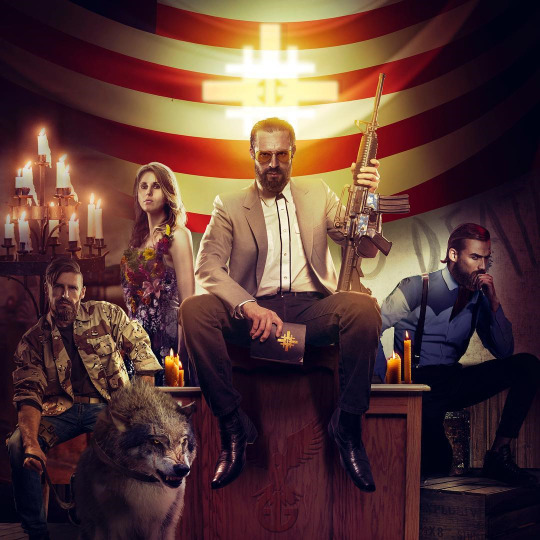
As you can see, many things look different from what we are used to, from the Eden’s Gate cross (behind Joseph’s head) and logo (on the pulpit, with an eagle) to the Seed siblings’ outfits. The man on the right seems to be John, and he’s sporting a two-tone blue shirt that resembles the one he will end up wearing in the game, but he doesn’t have a vest. Instead of a belt, he has suspenders, and his pants and shoes look darker and more formal than his usual jeans and boots. He already has a beard and, while his hair is slicked back, as it is in the game, it’s a little longer. He doesn’t have any visible tattoos, but if you look closely, you’ll notice that he does have something on his hand: blood, running from his knuckles.
In May 2017, nine months before Far Cry 5 came out, the game was officially announced and a few promotional pictures were released, notably these two²:
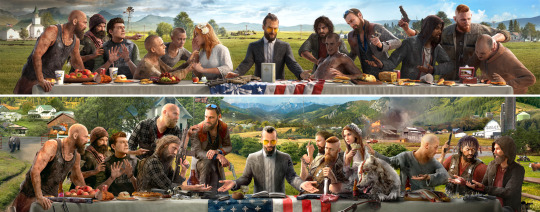
But before that, we can see what John looked like at an even earlier stage of the game’s development, during the making of those two aforementioned pictures, thanks to early sketches and visuals shared by AmCo Studio³ and Fire Without Smoke⁴:
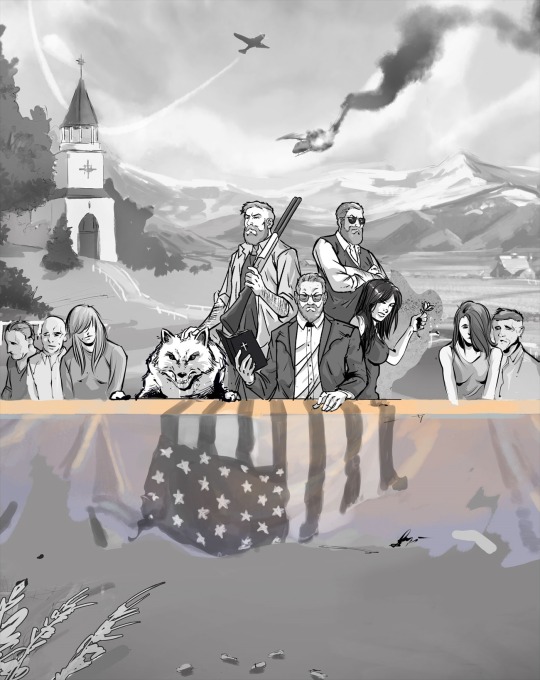
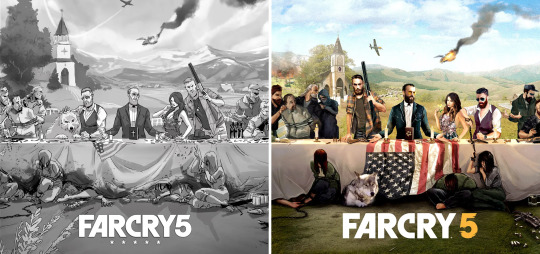
John’s iconic vest and sunglasses have appeared, and while his shirt became white, it’s now partially unbuttoned and the sleeves are rolled up, which is how he wears it in the game. As for his hair, it’s shorter than it was in the first family portrait and looks more similar to his final design. We still don’t see any tattoos on his arms, but he has a watch.
In the final version of what I would call the “Last-Supper-like” images, John looks even more like himself, but there are still a few differences:

Although they are not strictly identical to the ones he has in the game, he’s wearing sunglasses with blue lenses on his head. His shirt became blue again, his vest is striped, and he now has his “EG” (Eden’s Gate) earring and belt buckle, grey jeans, and bunker key around his neck. He’s also wearing a coat, but while, at first glance, it looks like the one we all know, the pattern isn’t the same; instead of planes, there are “EG” symbols on it. The buttons, however, are already golden and decorated with scales.
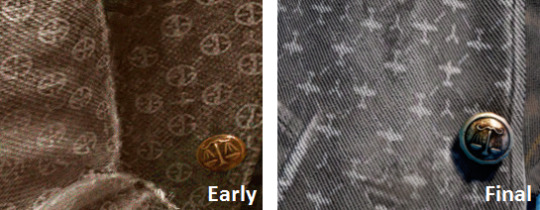
In the pictures, especially the first one, the siblings are associated with symbols: a crown for Joseph (on his jacket and napkin), a sword for Jacob (on his music box), a pair of scales for John (on his coat’s buttons and in the bread/cake), and intoxicating Bliss flowers for Faith, a reference to the Four Horsemen of the Apocalypse: Conquest, War, Famine, and Death, respectively, who. In John’s case, the scales could also be a nod to the fact he’s a lawyer. Indeed, scales are commonly used to symbolize justice.
This time, he finally has tattoos, and while some of them are the ones he will have in Far Cry 5, others are different. He already has small symbols on his fingers: an eye, a tongue, a hand with a drop of blood on it, a heart, a foot, a keyhole, and waves. The meaning of these symbols used to be a mystery to me, but it turns out they were inspired by Bible verses, specifically Proverbs 6:16-19⁵:
There are six things the Lord hates, seven that are detestable to him: haughty eyes, a lying tongue, hands that shed innocent blood, a heart that devises wicked schemes, feet that are quick to rush into evil, a false witness who pours out lies and a person who stirs up conflict in the community.
The flames on his right wrist will be in the game as well, but here, they are smaller. This tattoo seems to have been taken directly from this illustration:

It’s from a French (Breton, to be precise) collection of “Taolennoù Ar Mission” (literally “mission paintings” in Breton) by François-Marie Balanant, who was a priest, and it depicts a human soul being afflicted by the seven deadly sins⁶. “Taolennoù” were created in Brittany in the sixteenth century by the Catholic clergy in an effort to make religion more accessible to the faithful, some of whom were illiterate, with the help of drawings.
This particular image can be found on the Wikipedia page dedicated to the seven deadly sins⁷, which seems to have been the primary source of information and inspiration for several of John’s tattoos.
Clearly, the angelic figure with the dove, on his right hand, also directly comes from the drawing (upper left corner). This tattoo will later be redesigned and decorate the inner face of his left forearm.
As explained on Wikipedia, there used to be eight mortal sins, and their Latin names were:
Gula (Gluttony)
Luxuria (Lust)
Avaritia (Greed)
Tristitia (Sorrow)
Ira (Wrath)
Acedia (Sloth)
Vanagloria (Vainglory)
Superbia (Pride)
Tristitia and Acedia would later be combined, as well as Vanagloria and Superbia.
In the two promotional pictures, John has seven of these sins (except Acedia) tattooed on his left hand, as he does in Far Cry 5.
John also has letters on his fingers, but while, in the game, they spell “E-D-E-N” and “G-A-T-E”, here, we see G, G, S, E, W, P, and L, most likely the first letter of each deadly sin in English.
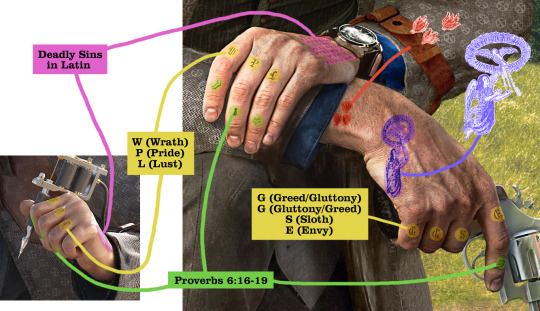
On his chest, instead of a scar and the mutilated word “SLOTH”, he has a tattoo. We see two crossed rifles, the number seven in tally marks (probably yet another reference to the deadly sins), what seems to be the words “Bros & Sis” above the design, and what probably is “Til Death” under it. It looks like an infantry tattoo, very similar to the example included below (center) by tattoo artist Garrett Tankersley, known as tat2garrett on Instagram⁸:

Finally, in one of the images, John is holding a tattoo machine. In the other, he’s holding a revolver. In the game, however, this weapon is nowhere to be seen.
Even though he will never use it in Far Cry 5, John was represented by this gun again on one of the game’s old official websites⁹:

At the time, as you can see, his title was also “The Inquisitor” instead of “The Baptist”.
On the PlayAsia blog, on a page dedicated to Far Cry 5, short information sheets about a few of the game’s characters were posted¹⁰. They look official, but since I have only ever seen them on this website, which was not created by Ubisoft, their origin and therefore the accuracy of the information they give are uncertain.
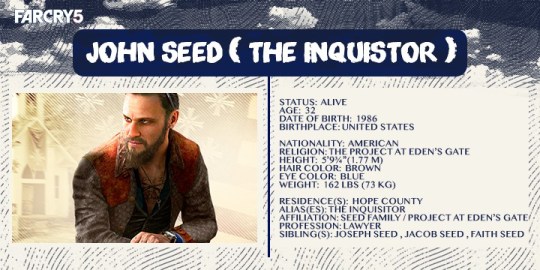
While most of what the picture says is either true (blue eyes, brown hair) or plausible (his height), John mathematically can’t be only 32 years old because he was already working as a lawyer about ten years before the events of the game, which is set in 2018. According to my research, it takes 7 years after graduating high school to become a licensed lawyer in the United States. In 2008, John couldn’t be younger than 18+7=25 years old, so it’s impossible for him to have been born after 1983. He could have skipped grades, but since this is never mentioned anywhere, I assume he didn’t and that he’s in fact older than 32 in Far Cry 5.
It’s possible, however, that he really was supposed to be 32 years old when the picture was made but that his backstory (and consequently his age) was then modified.
In the novel Far Cry Absolution, a few details are given about John’s appearance. For example, on page 6:
He was ten years older than [Mary May] and near six foot with brown hair and a beard that covered the lower half of his face.
Mary May is 29 (almost 30) in the novel, which makes John approximately 39 or 40 years old in the book. This age is more plausible, I think.
Then, on page 31:
John Seed, the younger brother of The Father, slighter in build, but cut from the same cloth. Both bearded and tattooed, and both with those all-seeing eyes that seemed to search through the dark with a kind of nocturnal prowess.
This isn’t the only time in the novel that John’s gaze is described as intense. The word “predatory” is even used on page 145.
Interestingly, and despite the fact it’s absent from Far Cry 5, the gun seen in his hand in one of the promotional pictures is mentioned in Absolution as well. It’s described as “a large revolver” on page 31 and as a “big magnum revolver” on page 57. He also uses a rifle “with a wood stock and bolt-action lever” (page 48) at one point, but this weapon isn’t in the game either.
Overall, aside from this detail, his physical description in the book is rather consistent with what we see in the game. And in this official picture posted in January 2018 to promote the book¹¹, he apparently looks the same as he does in Far Cry 5.

In the live-action short film Inside Eden’s Gate¹², Joseph is the only member of the Seed family who is played by the actor who also plays him in Far Cry 5, Greg Bryk. In the game, while John is played by Seamus Dever, in the movie, it’s another actor named Rob Evors who was cast in the role. His voice and face obviously don’t sound and look exactly like John’s, so these differences are not significant.
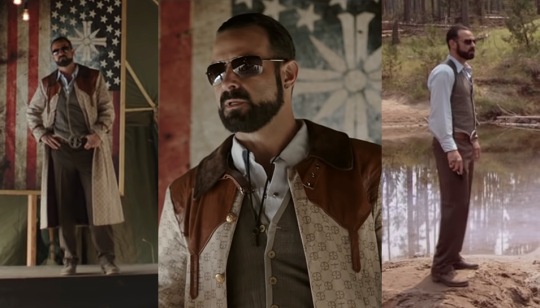
His outfit, however, has gone through several changes. I don’t know if the design was deliberately altered or if the clothes Rob Evors has in the film simply are the closest real-life equivalent to the ones John is wearing in the promotional pictures that the movie’s costume designers could get their hands on. Like in the development sketches for the “Last-Supper-like” images, his shirt is light-colored (but still blue, apparently) and he’s wearing his sunglasses normally, not on his head. They don’t seem to have blue lenses, but again, maybe the team could only find “regular” sunglasses. He has his Eden’s Gage belt buckle and earring, but instead of being grey, his coat, vest, pants, and shoes are brown/beige. The coat is decorated with “EG” logos, exactly like the one John is wearing in the promotional pictures, but lighter in color.
As for his tattoos, they are identical to the “old” ones we’ve seen so far, but two more are visible: the pair of scales on the side of his thumb and the snake (from the Taolennoù Ar Mission again, but uncoiled), which represents Envy, around his left wrist. These two new tattoos will be part of John’s final design in the game.
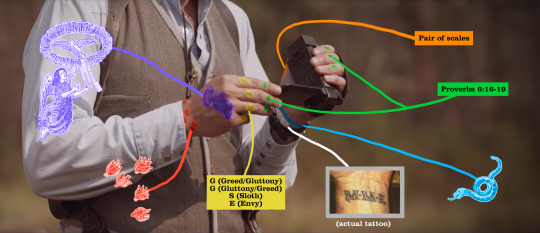
There’s another one between the snake and his watch, but it’s simply one of Rob Evors’¹³.
In the film, John’s tattoos were actually hand-painted¹⁴. Here’s a better look a them, from Makeup Artist Casey Lynn Stuckey’s Instagram account:
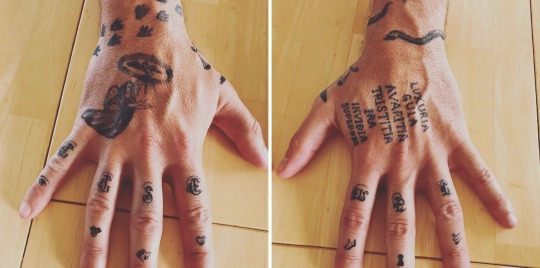
His sleeves are never rolled up in Inside Eden’s Gate, but it’s most likely because that would have meant covering up the actor’s actual tattoos and possibly painting more, so I suppose they thought it was more convenient to just hide them.
The last notable change regarding John’s appearance in the short film is that, for the first and seemingly only time, he’s wearing a shoulder holster, but his gun is not the revolver we’ve seen for far. Instead, it looks like a semi-automatic pistol, maybe a 1911. Since, in Inside Eden’s Gate, Joseph also has this type of gun and not the revolver he carries in Far Cry 5 (albeit rarely, and he never uses it), it’s possible that, once again, the team couldn’t find the right weapons for the movie and used the available props.
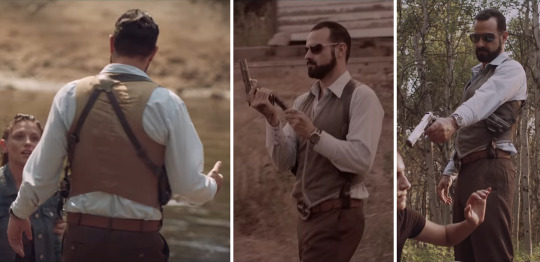
In the live-action TV spot “Anything Can Happen, Everything Will”¹⁵, John is this time played by model and actor Jon Oswald, who jokingly described the character as “the asshole in the Gucci trench coat” when he shared the video on his Instagram account¹��.
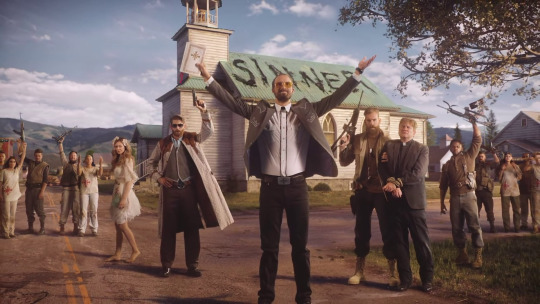
John’s outfit looks identical to Rob Evors’ in Inside Eden’s Gate (except the shoes and the holster, it seems), so it’s likely that they just reused the same clothes. Like in the film, John’s sunglasses (which are not blue) aren’t on his head; he’s wearing them. His hair is a bit different, but it’s probably simply because Jon Oswald’s hairstyle looked close enough to John’s and they thought it didn’t need to be modified, so I don’t think this “change” is significant.
Thanks to the pictures that Mackenzie Lawrén Johnson (better known as Kenz Lawrén), who plays Faith Seed in the short film and the TV spot, posted on Instagram¹⁷, we can have a better look at him and his tattoos.
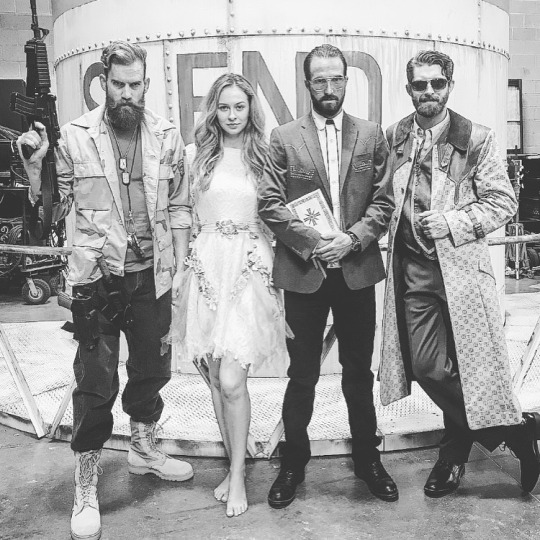

They haven’t changed much compared to the previous ones, but we can now see a goat (a symbol for Lust, also directly from the Taolennoù Ar Mission) next to the snake on his left arm. In the game, the goat will disappear from his hand, be redesigned, and end up on his right forearm. We see two other tattoos in the picture, but they simply are Jon Oswald’s¹⁸.
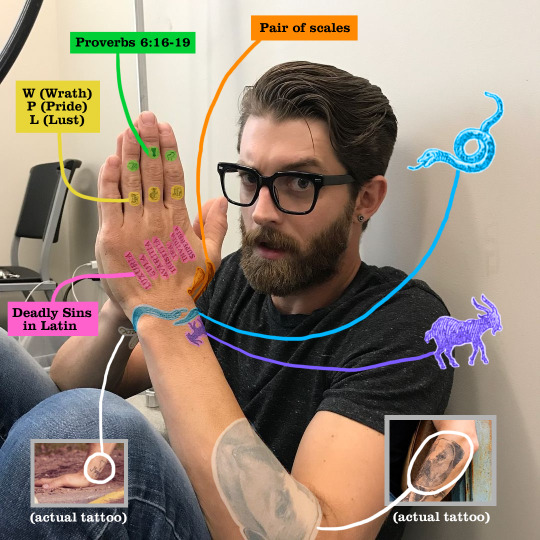
In the image below, drawn by Anthony Winn, who made storyboards for the TV spot¹⁹, the character on the far right (who is not Joseph), wearing a vest and sunglasses, and standing next to a woman who is probably Faith, appears to be an early version of John. This time, he’s holding a rifle, different from the one described in Absolution, and not a handgun. For once, his sister is armed as well.
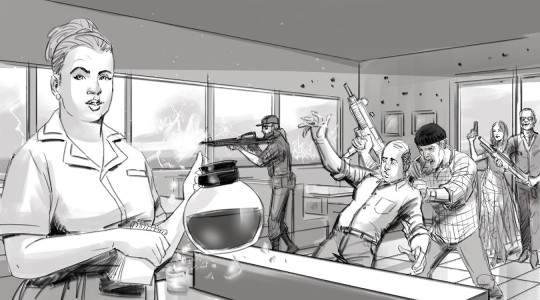
In The Book of Joseph²⁰, John, as a child, is described as “the best looking, the least odd” of the Seed brothers, which is why the narrator, Joseph himself, believes he was adopted first after they were sent to an orphanage. When they meet again as adults, Joseph says his younger brother is “strikingly handsome, elegant”, wears “tailored suits” and very expensive shoes, has gleaming hair, shiny teeth, and manicured hands. He also writes that, as John Duncan (the name of his adoptive parents), “physically, he was society’s very model of success”. Psychologically, however, it was another story… but this will be discussed later. Although the John Seed we meet in the game isn’t exactly the same person as John Duncan was anymore, he’s still “elegant” and seems to take care of his appearance. Joseph doesn’t mention tattoos, but it’s likely that John got them later, after the Project was created.
An official guide for Far Cry 5, by Prima Games, was released alongside it. In the book, which was written in 2017, we get to see what John looked like when the game was still in development.
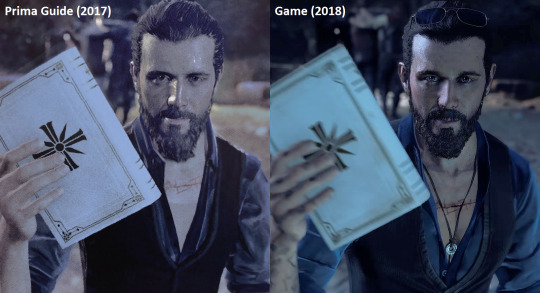
This design is very close to the final one, but for some reason, his sunglasses, bunker key, earring, and tattoos are all (temporarily) gone. However, the “SLOTH” scar has now appeared on his chest instead of the tattoo he previously had, even though it’s a bit closer to his collarbone than it will be in the game. His outfit and facial features look slightly different, but this is also true for many other characters in the guide.
On IGN’s YouTube channel, a video titled “Far Cry 5: Why John Seed Is Your Charmingly Deadly Enemy” was uploaded in February 2018²¹. In it, we get a glimpse of an early version of the “You have been Marked” TV broadcast²², and although the setting looks different, John’s appearance is very close to his final one.

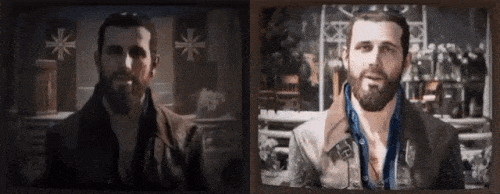
By the way, if you look at the noticeboard behind the TV, you’ll see that the Testicle Festival was supposed to take place in 2017 instead of 2018. When this early in-game footage was recorded, Far Cry 5 was probably still scheduled to come out in September 2017 (which is what the first rumors said and could also explain why all the calendars in the game suggest we are in September).
In the thumbnail of the YouTube video, John looks exactly like himself:
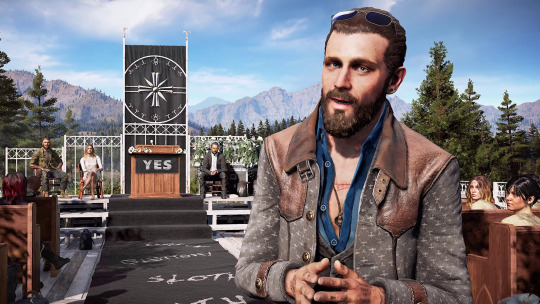
He does too in the “Four Horsemen of the Apocalypse” artwork²³, this promotional screenshot²⁴, and this poster²⁵:

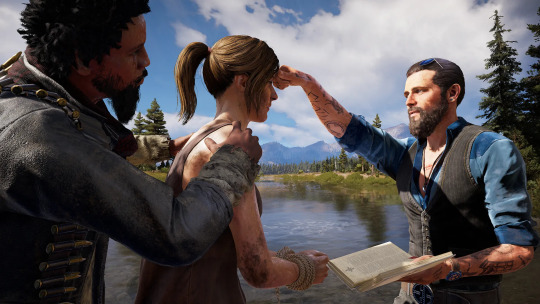
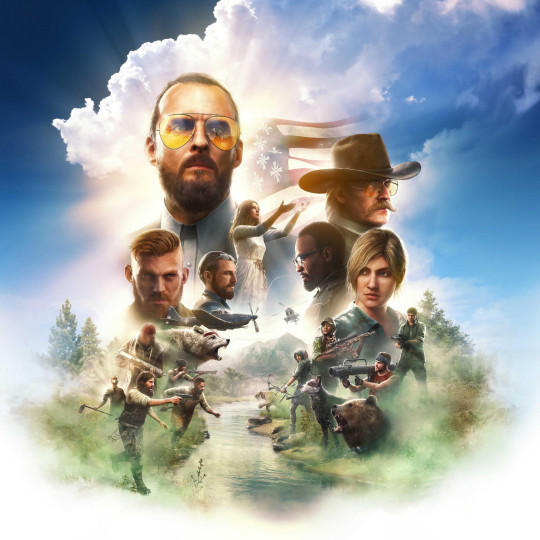
And in a trailer posted by Ubisoft three weeks before the release of Far Cry 5, a “character spotlight”²⁶, John has his final design as well. The only difference is that, although the game was about to come out, they still called him “The Inquisitor” instead of “The Baptist”.
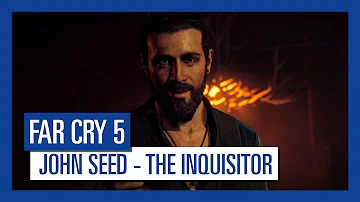
Then, on March 27, 2018, Far Cry 5 was released.
To be continued…
#far cry 5#john seed#joseph seed#jacob seed#faith seed#far cry absolution#mary may fairgrave#the book of joseph#inside eden’s gate#rob evors#jon oswald
292 notes
·
View notes
Text
DA:TV thoughts, part one
Hello, curious friends!
After trying to put them in order, here are some of my thoughts/theories about Dragon Age: The Veilguard! They are mostly about Rook as a character and the tone of the game. Part two here.
Spoilers for all and everything Dragon Age.
TL;DR: DA:TV is not the story of Rook; it's The Veilguard's. We see it through Rook, who tells it to us in the style of Varric's books.
_____
ABOUT ROOK : What is a Hero?
DA:TV is not Rook's story
In Thedas, our Warden from DAO is remembered as The Hero of Ferelden, Hawke is The Champion of Kirkwall, and in DAI our character becomes The Herald of Andraste and The Inquisitor. All three are people who became legends, names and stories bigger than themselves.
In DA:TV, Rook leads the Veilguard, but I think our group will be what is remembered. In the end, it's your companions that become "Heroes of the Veilguard." As the leader, Rook unites them and gets them ready to save the world: They are definitely part of the story, but they are not the main character.
Like Varric intended.
The kind of hero(es) we need
I think I'm not alone here in finding the state of the real world worrying. It often feels like we're overrun by hate and that we can't be saved.
Before DA:TV, Thedas is going through the same thing. Pride is about to cause the death of even more people than it already has. Venatori cultists, the slavery-loving "Make Tevinter Great Again" assholes, and different Antaam colonialists and dictators are getting restless.
Before recruiting Rook, Varric faced a question: "When everything is going to shit, who is going to save us? What kind of hero does Thedas need right now?"
Varric has an excellent eye for finding Heroes, but has written enough of their stories to know they often end in tragedy. He has also lived through enough of those stories himself to know that behind the Hero there are lots of people willing to lend their talents to the cause. He knows the answer is not "one very special, or unlucky, person"; it's "many people willing to help by bringing their skills to the table and working together.
Varric also knew he could die at any moment, especially when trying to stop his friend Solas. He knew he probably wouldn't see the end of this tale. So he found Rook and has been preparing them to take his place by teaching them lessons when they were travelling together. I'm guessing he told them about the events of the first three games, to some extent. Everything "he" tells Rook in the lighthouse is things your mind pieces together from your memories of him, the lessons he already taught them. Varric's good eye and lessons are why all Rooks have in common at least some maturity and kindness. That was inevitable in anyone Varric would have chosen and mentored. Their talent as a positive leader is what they bring to the table.
Even if I understand why that's frustrating to some players, it makes a lot of sense to me that Rook can't really antagonize their companions or be mean to them like in the other games. That Rook wouldn't have brought the Veilguard together to save the world. In the same way, I think you can't really "import" an Inquisitor that wasn't at least respectful to Solas, because that mean/antagonistic Inquisitor has doomed the world. It's said a few times that Solas left clues to be followed by Varric and Harding because a part of him wants to be stopped. That doesn't happen in a world where an Inquisitor hasn't shown Solas that modern people are worth saving.
To me, this is the game telling us how to save the world. We need to organize and do what we can, and that's way easier to do while being open-minded and kind to each other.
In the very beginning of the game, Varric asks the player, "Who are you?" No matter where you are from in Thedas, your background, your past, what you look like, or what your gender identity is, YOU can be Rook. Because we can all make the world a better place.
part two
22 notes
·
View notes